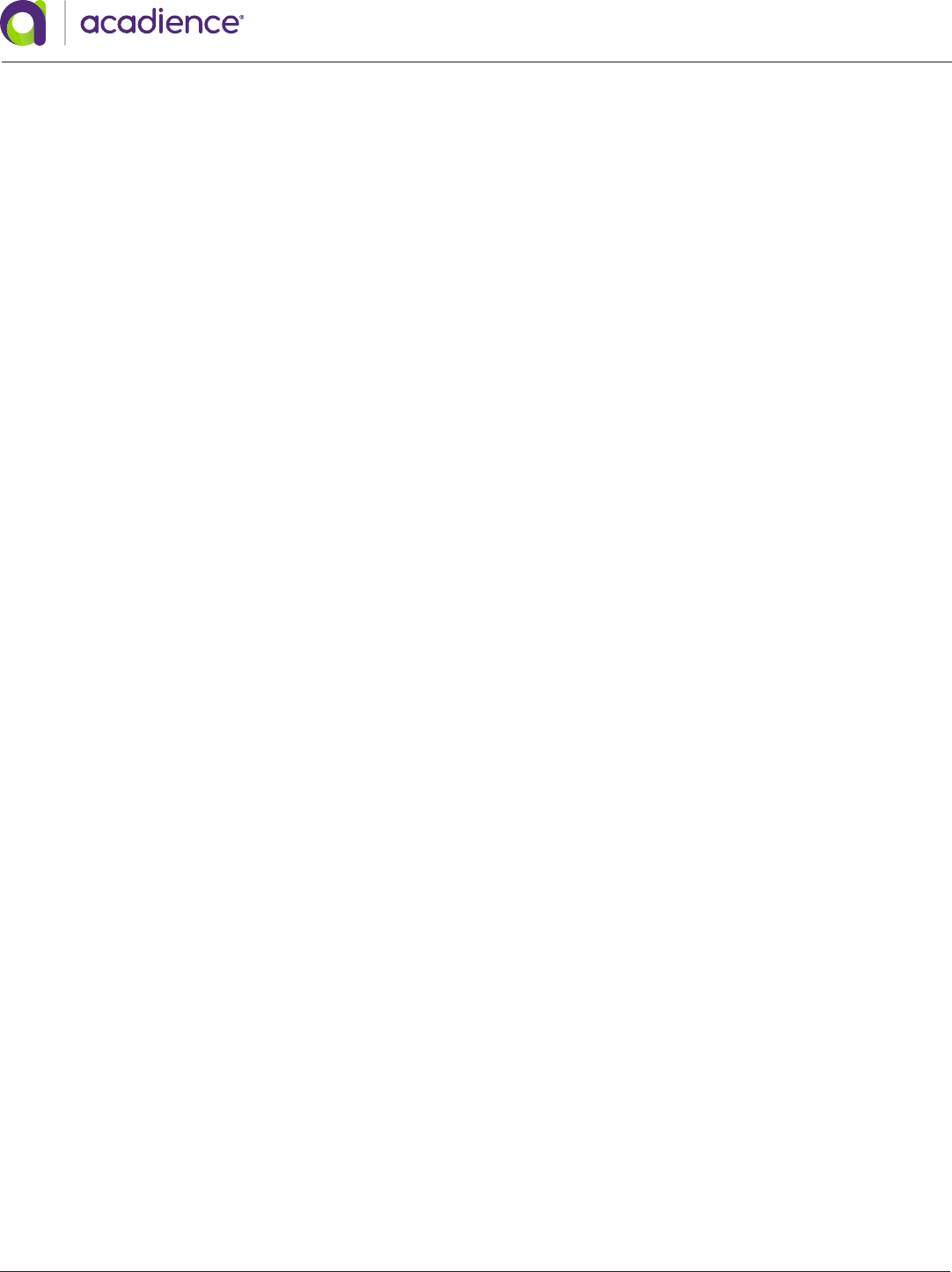
© 2021 Acadience Learning Inc. All Rights Reserved. Acadience is a registered trademark of Acadience Learning Inc.
1
Acadience Reading K–6 provides two types of scores at each benchmark assessment period: (a) a raw score for each
individual measure and (b) a composite score (the Reading Composite Score). Each of the scores is interpreted relative to
benchmarks and cut points for risk to determine if a student’s score is at or above the benchmark, below the benchmark,
or below the cut point for risk (well below the benchmark).
Benchmarks and Cut Points for Risk
Acadience Reading benchmarks are empirically derived, criterion-referenced target scores that represent adequate
reading skill for a particular grade and time of year. Benchmarks and cut points for risk are provided for the Reading
Composite Score as well as for the individual Acadience Reading measures. Benchmarks and cut points for Acadience
Reading are based on research that examines the predictive validity of a score on a measure at a particular point in time,
compared to later Acadience Reading measures and external outcome assessments.
A benchmark indicates a level of skill at which students are likely to score above the 40th percentile on any high-quality
reading assessment and achieve the next Acadience Reading benchmark or reading outcome. Thus, for students who
achieve a benchmark and are receiving effective, research-based instruction from a core classroom curriculum, the odds
are in their favor of achieving later reading outcomes.
Conversely, the cut points for risk indicate a level of skill below which students are unlikely to achieve subsequent reading
outcomes without receiving additional, targeted instructional support. For students who have scores below the cut point for
risk, the probability of achieving later benchmarks is low unless intensive support is provided.
The Acadience Reading benchmarks and cut points for risk provide three primary benchmark status levels that describe
students’ performance: (a) At or Above Benchmark, (b) Below Benchmark, and (c) Well Below Benchmark. These levels
are based on the overall likelihood of achieving specied benchmarks on subsequent Acadience Reading assessments or
external measures of reading achievement.
At or Above Benchmark. For students who score at or above the benchmark, the overall likelihood of achieving
subsequent reading benchmarks is approximately 80% to 90%. These students are likely to need effective core
instruction to meet subsequent early literacy and/or reading benchmarks. Within this range, the likelihood of achieving
subsequent benchmarks is lower for students whose scores are right at the benchmark and increases as scores
increase above the benchmark (see Table 1). A score at or above the benchmark indicates that the odds are in the
student’s favor of achieving the next benchmark, but it is not a guarantee. For example, if students at or above the
benchmark have an 85% chance of meeting the next benchmark, that means that 15% of students in the At or Above
Benchmark range may not achieve the subsequent benchmark. Some students who achieve scores at or above the
benchmark may still need supplemental support to achieve the next benchmark. It is important to attend to other
indicators of risk when planning support for students, such as attendance, behavior, motivation, vocabulary and
language skills, and other related skill areas.
To assist in setting ambitious goals for students, the At or Above Benchmark level is subdivided into At Benchmark and
Above Benchmark levels.
At Benchmark. In the At Benchmark range, the overall likelihood of achieving subsequent early literacy and/or
reading benchmarks is 70% to 85%. Some of these students, especially those with scores near the benchmark,
may require monitoring and/or strategic support on specic component skills.
Above Benchmark. In the Above Benchmark range, the overall likelihood of achieving subsequent early literacy
and/or reading benchmarks is 90% to 99%. While all students with scores in this range will likely benet from core
support, some students with scores in this range may benet from instruction on more advanced skills.
reading k–6
Benchmarks and Composite Score
© Acadience Learning Inc. / March 11, 2021

© 2021 Acadience Learning Inc. All Rights Reserved. Acadience is a registered trademark of Acadience Learning Inc.
2
Below Benchmark. Between the benchmark and cut point for risk is a range of scores where students’ future
performance is more difficult to predict. For students with scores in this range, the overall likelihood of achieving
subsequent early literacy and/or reading benchmarks is approximately 40% to 60%. In this range, a student’s future
performance is harder to predict. These students are likely to need strategic support to ensure their achievement of future
benchmarks. Strategic support generally consists of carefully targeted supplemental support in specic skill areas in which
students are having difficulty. To ensure that the greatest number of students achieve later reading success, it is best for
students with scores in this range to be monitored regularly to ensure that they are making adequate progress and to
receive increased or modied support if necessary to achieve subsequent reading benchmarks.
Well Below Benchmark. For students who score below the cut point for risk, the overall likelihood of achieving
subsequent early literacy and/or reading benchmarks is low, approximately 10% to 20%. These students are identied
as likely to need intensive support. Intensive support refers to interventions that incorporate something more or
something different from the core curriculum or supplemental support.
Intensive support might entail:
• delivering instruction in a smaller group or individually,
• providing more instructional time or more practice,
• presenting smaller skill steps in the instructional hierarchy,
• providing more explicit modeling and instruction, and/or
• providing greater scaffolding and practice.
Because students who need intensive support are likely to have individual needs, we recommend that their progress be
monitored frequently and their intervention modied dynamically to ensure adequate progress.
To gain a better understanding of what Acadience Reading results mean in a local context, districts and schools can
examine the linkages between the Acadience Reading benchmarks and cut points for risk and their own outcome
assessments, such as state-level criterion-referenced tests. By comparing Acadience Reading measures to an outcomes
assessment (e.g., Buck & Torgesen, 2003; Wilson, 2005), and by calculating conditional probabilities (e.g., “80% of
students at benchmark on Acadience Reading ORF at the end of third grade met the Procient level on the state criterion-
referenced test”), schools can determine how the Acadience Reading benchmarks compare to their own external criteria.
The Acadience Reading benchmarks and cut points for risk, along with a brief description of how the Acadience Reading
benchmarks were developed, are described in the sections below.
Table 1 summarizes the design specications for achieving later reading outcomes and provides descriptions for the likely
need for support for each of the benchmark status levels. It is important to note that while there is an overall likelihood for
each benchmark status level, within each level the likelihood of achieving later reading outcomes increases as students’
scores increase. This is illustrated in the rst column of Table 1.
Development of Benchmarks
The Acadience Reading benchmarks, cut points for risk, and Composite Score were developed based upon data collected
in a study conducted during the 2009–2010 school year. The benchmarks are based on research that examined the
predictive probability of a score on a measure at a particular point in time, compared to later Acadience Reading measures
and external measures of reading prociency and achievement. The external criterion measure of reading prociency was
the Group Reading and Diagnostic Evaluation (GRADE; Williams, 2001). The 40th percentile on the GRADE assessment
was used as an indicator that the students had adequate early literacy and/or reading skills for their grade. Data for the
study were collected in thirteen elementary and middle schools in ve states. Data collection included administering the
Acadience Reading measures to participating students in grades K–6 in addition to the GRADE. Participants in the study
were 3,816 students across grades K–6 from general education classrooms who were receiving English language reading
instruction, including students with disabilities and students who were English language learners, provided they had the
response capabilities to participate. The study included both students who were struggling in reading and those who
were typically achieving. A subset of the total sample participated in the GRADE assessment (n = 1,306 across grades
K–6). Additional information about the study can be found in DIBELS Next®
1
: Findings from the Benchmark Goals Study,
available from www.acadiencelearning.org.
1
Acadience
®
Reading K–6 is the new name for the DIBELS Next
®
assessment. Acadience is a registered trademark of Acadience Learning Inc. The DIBELS Next copyrighted content is owned by
Acadience Learning Inc. The DIBELS
®
and DIBELS Next registered trademark was sold by Acadience Learning Inc. to the University of Oregon (UO) and is now owned by the UO.
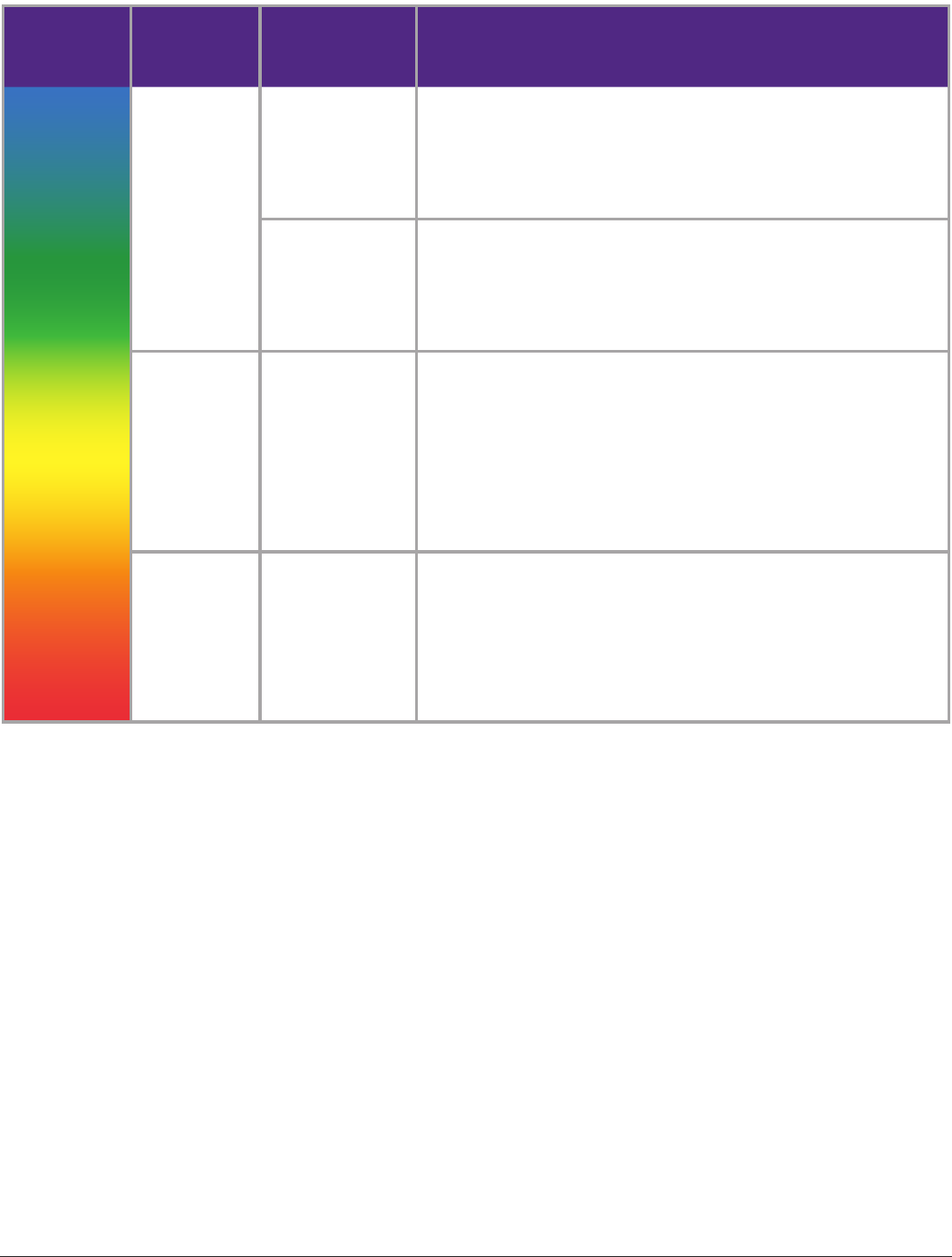
© 2021 Acadience Learning Inc. All Rights Reserved. Acadience is a registered trademark of Acadience Learning Inc.
3
Table 1. Student Performance Interpretations
Benchmark
Status
Benchmark Status
Including Above
Benchmark What It Means
>99%
95%
90%
80%
70%
60%
55%
50%
45%
40%
30%
20%
10%
<5%
At or Above
Benchmark
overall likelihood
of achieving
subsequent
early literacy
benchmarks:
80% to 90%
Above Benchmark
overall likelihood
of achieving
subsequent early
literacy benchmarks:
90% to 99%
For students with scores in this range, the odds of achieving subsequent early
literacy/reading benchmarks are very good. The higher above the benchmark,
the better the odds.
These students likely need effective core instruction to meet subsequent early
literacy/reading goals. Some students may benefit from instruction on more
advanced skills.
At Benchmark
overall likelihood
of achieving
subsequent early
literacy benchmarks:
70% to 85%
For students with scores in this range, the odds are in favor of achieving
subsequent early literacy/reading benchmarks. The higher above the
benchmark, the better the odds.
These students likely need effective core instruction to meet subsequent early
literacy/reading benchmarks. Some students may require monitoring and
strategic support on specific component skills as needed.
Below
Benchmark
overall likelihood
of achieving
subsequent
early literacy
benchmarks:
40% to 60%
Below Benchmark
overall likelihood
of achieving
subsequent early
literacy benchmarks:
40% to 60%
For students with scores in this range, the overall odds of achieving subsequent
early literac
y/reading benchmarks are approximately even, and hard to predict.
Within this range, the closer students’ scores are to the benchmark, the better
the odds; the closer students’ scores are to the cut point, the lower the odds.
These students likely need core instruction coupled with strategic support,
targeted to their individual needs, to meet subsequent early literacy/reading
benchmarks. For some students whose scores are close to the benchmark,
effective core instruction may be sufficient; students whose scores are close to
the cut point may require more intensive support.
Well Below
Benchmark
overall likelihood
of achieving
subsequent
early literacy
benchmarks:
10% to 20%
Well Below
Benchmark
overall likelihood
of achieving
subsequent early
literacy benchmarks:
10% to 20%
For students with scores in this range, the overall odds of achieving
subsequent early literacy/reading benchmarks are low.
These students likely need intensive support in addition to effective
core instruction. They may also need support on prerequisite skills (i.e.,
below grade level) depending upon the grade level and how far below the
benchmark their skills are.
Likelihood of
Meeting Later
Reading
Benchmarks
The addition of the Above Benchmark status level has not changed the benchmarks. A benchmark is still the point at which the odds are in the student’s favor of meeting later reading benchmarks
(approximately 60% likelihood or higher). The higher above the benchmark the student scores, the better the odds. For students who are already at benchmark, the Above Benchmark status level also
provides a higher benchmark to aim for. “Overall likelihood” refers to the approximate percentage of students within the category who achieve later benchmarks, although the exact percentage varies by
grade, year, and measure.Instructional decisions should be made based on students’ patterns of performance across all measures, in addition to other available information on student skills, such as
diagnostic assessment or in-class work. Acadience is a registered trademark of Acadience Learning Inc. www.acadiencelearning.org
Reading Composite Score
The Reading Composite Score (RCS) is a combination of multiple Acadience Reading scores and provides the best overall
estimate of students’ early literacy skills and/or reading prociency. Most data management services will calculate the RCS
for you, provided that all required measures necessary for calculating it have been administered. To calculate the RCS
yourself, see the Reading Composite Score Worksheets at the end of this document.
Benchmarks and cut points for risk for the RCS are based on the same logic and procedures as the benchmarks for the
individual Acadience Reading measures. However, because the RCS provides the best overall estimate of a student’s skills,
it should generally be interpreted rst. If a student earns a RCS that is at or above the benchmark, the odds are in the
student’s favor of reaching later important reading outcomes. Some students who score At or Above Benchmark on the RCS
may still need additional support in one of the essential early literacy and reading skills, as indicated by a Below Benchmark
score on an individual Acadience Reading measure (FSF, PSF, NWF, ORF, or Maze). This potential need for additional
support is especially true for a student whose RCS is close to the benchmark.
The Acadience Reading measures that are used to calculate the RCS vary by grade and time of year. As such, the RCS
is not comparable across different grades and does not provide a direct measure of growth across grades. For grades K
through 2, the RCS is also not comparable across different times of year and should not be used as an indicator of growth
within a grade. However, because the logic and procedures used to establish benchmarks are consistent across grades
and times of year, the percent of students at different benchmark status levels can be compared, even though the mean
scores are not comparable.

© 2021 Acadience Learning Inc. All Rights Reserved. Acadience is a registered trademark of Acadience Learning Inc.
4
References
Buck, J., & Torgesen, J. (2003). The relationship between performance on a measure of Oral Reading Fluency and
performance on the Florida Comprehensive Assessment Test. (FCRR Technical Report #1) Tallahassee, FL: Florida
Center for Reading Research.
Williams, K.T. (2001). Group Reading Assessment and Diagnostic Evaluation (GRADE). New York: Pearson.
Wilson, J. (2005). The relationship of Dynamic Indicators of Basic Early Literacy Skills (DIBELS) Oral Reading Fluency to
performance on Arizona Instrument to Measure Standards (AIMS). Tempe, AZ: Tempe School District No. 3.

© 2021 Acadience Learning Inc. All Rights Reserved. Acadience is a registered trademark of Acadience Learning Inc.
5
Acadience
®
Reading: Summary of Benchmarks and Cut Points for Risk
38 156 152 129 177 208 202 256 287 289 349 405 341 383 446 386 411 466 435 461 478
26 122 119 113 130 155 141 190 238 220 285 330 290 330 391 357 372 415 344 358 380
13 85 89 97 100 111 109 145 180 180 235 280 245 290 330 258 310 340 280 285 324
16 43
10 30
5 20
44 56 47
20 40 40
10 25 25
Correct
Letter
Sounds
28 40 34 59 81 72
17 28 27 43 58 54
8 15 18 33 47 35
4 17 25 21
Whole
Words
Read
1 8 13 13
0 3 6 6
34 67 68 91 104 90 105 118 104 121 133 121 133 143 139 141 151
Words
Correct
23 47 52 72 87 70 86 100 90 103 115 111 120 130 107 109 120
16 32 37 55 65 55 68 80 70 79 95 96 101 105 90 92 95
Accuracy
86% 97% 96% 99% 99% 98% 99% 99% 98% 99% 100% 99% 99% 100% 99% 99% 100%
78% 90% 90% 96% 97% 95% 96% 97% 96% 97% 98% 98% 98% 99% 97% 97% 98%
68% 82% 81% 91% 93% 89% 92% 94% 93% 94% 95% 95% 96% 97% 94% 94% 96%
Retell
17 25 31 39 33 40 46 36 39 46 40 46 52 43 48 50
15 16 21 27 20 26 30 27 30 33 33 36 36 27 29 32
0 8 13 18 10 18 20 14 20 24 22 25 25 16 18 24
Retell
Quality of
Response
2 2 2 2 3 2 2 3 2 3 3 2 2 3
1 1 1 1 2 1 1 2 1 2 2 1 1 2
11 16 23 18 20 28 21 21 28 27 30 30
8 11 19 15 17 24 18 20 24 18 19 21
5 7 14 10 12 20 12 13 18 14 14 15
Beg
Mid
End
Beg
Mid
End
Beg
Mid
End
Beg
Mid
End
Beg
Mid
End
Beg
Mid
End
Beg
Mid
End
Kindergarten First Grade Second Grade
Third Grade Fourth Grade Fifth Grade Sixth Grade
Note: There is no benchmark for Letter Naming Fluency (LNF).
Acadience is a registered trademark of Acadience Learning Inc. This page is adapted from a chart developed by Cache County School District.
Reading Composite Score: A combination of multiple Acadience Reading scores, which provides the best overall
estimate of the student’s reading prociency. For information on how to calculate the composite score, see the
Acadience Reading Composite Score worksheets on pages 21–27.
ABOVE BENCHMARK (small blue number in each box): Students scoring above the benchmark are highly
likely to achieve important reading outcomes (approximately 90% to 99%). These scores are identied as Above
Benchmark. While students scoring Above Benchmark are likely to need Core Support, some may benet from
instruction on more advanced skills.
BENCHMARK (large bold number in the middle of the box): Students scoring at or above the benchmark have the
odds in their favor (approximately 80% to 90%) of achieving later important reading outcomes. These scores are
identied as At or Above Benchmark and the students are likely to need Core Support.
CUT POINT FOR RISK (small red number in each box): Students scoring below the cut point for risk are unlikely
(approximately 10%–20%) to achieve subsequent benchmarks without receiving additional, targeted instructional
support. These scores are identied as Well Below Benchmark and the students are likely to need Intensive Support.
Scores below the benchmark and at or above the cut point for risk are identied as Below Benchmark. In this
range, a student’s future performance is harder to predict, and these students are likely to need Strategic Support.
Reading Composite Score
First Sound Fluency (FSF)
Phoneme Segmentation Fluency (PSF)
Nonsense Word Fluency (NWF)
Oral Reading Fluency (ORF)
Maze Adjusted Score
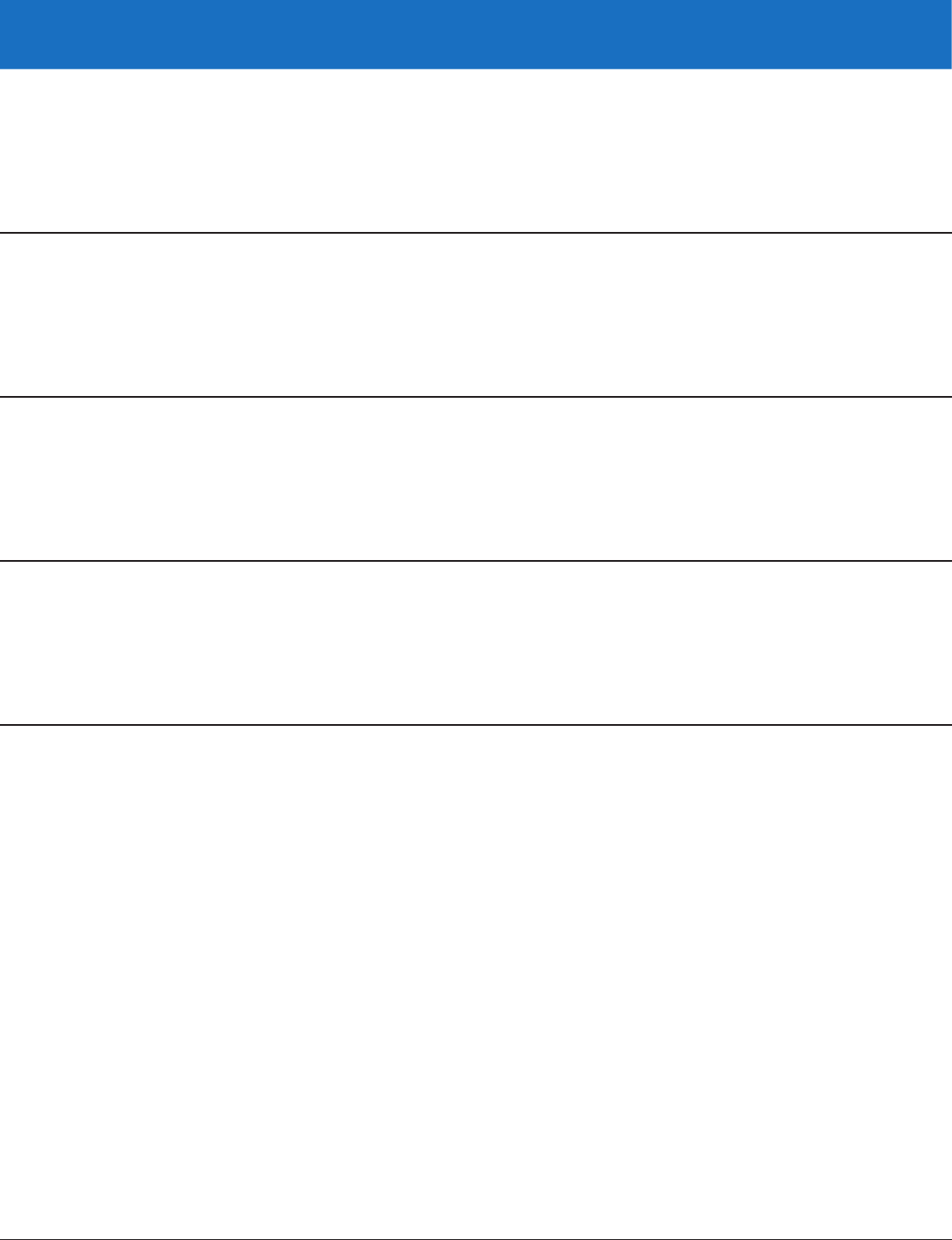
© 2021 Acadience Learning Inc. All Rights Reserved. Acadience is a registered trademark of Acadience Learning Inc.
6
Kindergarten Benchmarks and Cut Points for Risk
Acadience
Reading
Measure
Benchmark
Status Likely Need for Support
Beginning
of Year
Middle
of Year
End
of Year
Reading
Composite
Score
Above Benchmark Likely to Need Core Support
a
38 + 156 + 152 +
At Benchmark Likely to Need Core Support
b
26 - 37 122 - 155 119 - 151
Below Benchmark Likely to Need Strategic Support
13 - 25 85 - 121 89 - 118
Well Below Benchmark Likely to Need Intensive Support
0 - 12 0 - 84 0 - 88
FSF
Above Benchmark Likely to Need Core Support
a
16 + 43 +
At Benchmark Likely to Need Core Support
b
10 - 15 30 - 42
Below Benchmark Likely to Need Strategic Support
5 - 9 20 - 29
Well Below Benchmark Likely to Need Intensive Support
0 - 4 0 - 19
PSF
Above Benchmark Likely to Need Core Support
a
44 + 56 +
At Benchmark Likely to Need Core Support
b
20 - 43 40 - 55
Below Benchmark Likely to Need Strategic Support
10 - 19 25 - 39
Well Below Benchmark Likely to Need Intensive Support
0 - 9 0 - 24
NWF-CLS
Above Benchmark Likely to Need Core Support
a
28 + 40 +
At Benchmark Likely to Need Core Support
b
17 - 27 28 - 39
Below Benchmark Likely to Need Strategic Support
8 - 16 15 - 27
Well Below Benchmark Likely to Need Intensive Support
0 - 7 0 - 14
The benchmark is the number that is bold. The cut point for risk is the number that is italicized.
a
Some students may benet from instruction on more advanced skills.
b
Some students may require monitoring and strategic support on component skills.
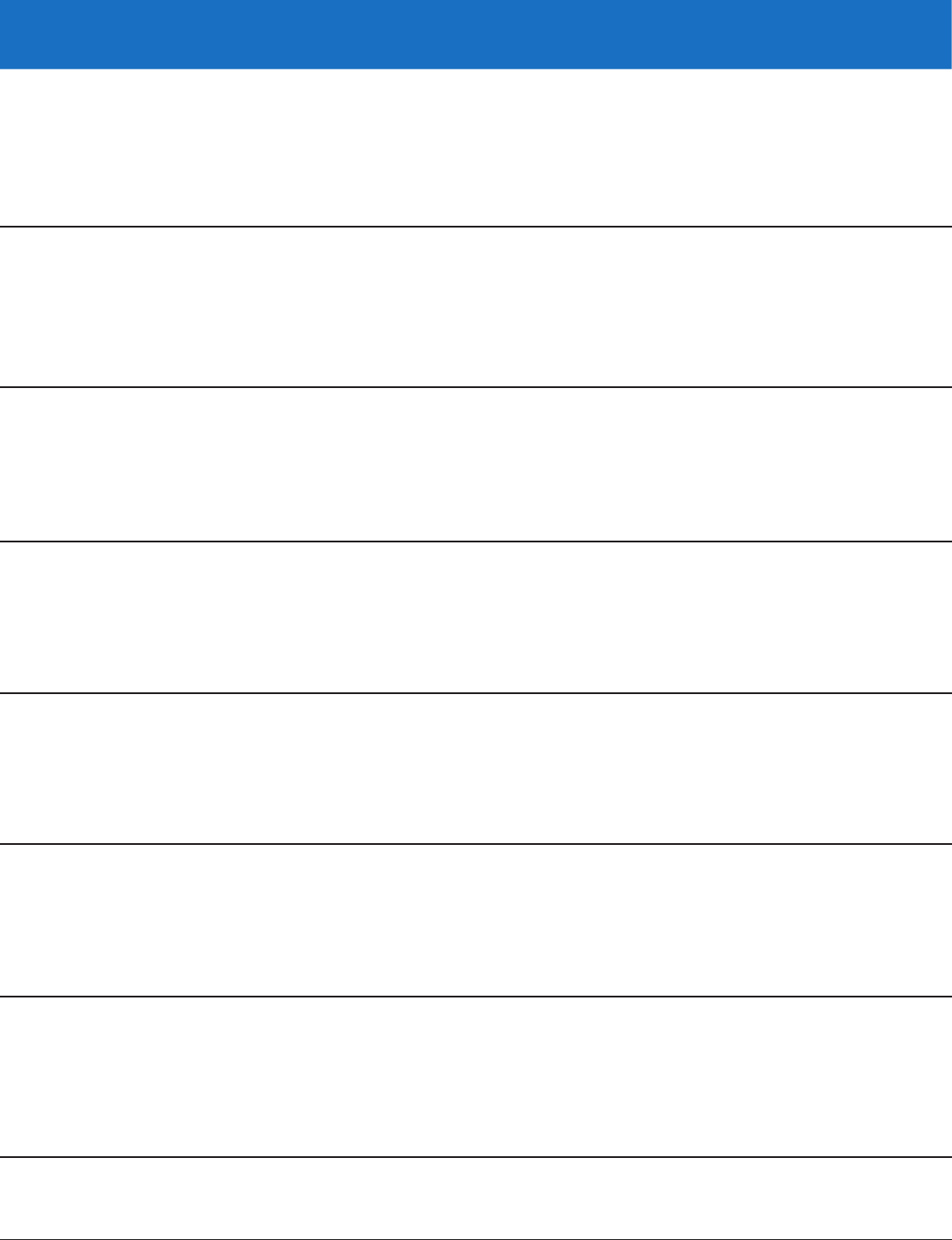
© 2021 Acadience Learning Inc. All Rights Reserved. Acadience is a registered trademark of Acadience Learning Inc.
7
First Grade Benchmarks and Cut Points for Risk
Acadience
Reading
Measure
Benchmark
Status Likely Need for Support
Beginning
of Year
Middle
of Year
End
of Year
Reading
Composite
Score
Above Benchmark Likely to Need Core Support
a
129 + 177 + 208 +
At Benchmark Likely to Need Core Support
b
113 - 128 130 - 176 155 - 207
Below Benchmark Likely to Need Strategic Support
97 - 112 100 - 129 111 - 154
Well Below Benchmark Likely to Need Intensive Support
0 - 96 0 - 99 0 - 110
PSF
Above Benchmark Likely to Need Core Support
a
47 +
At Benchmark Likely to Need Core Support
b
40 - 46
Below Benchmark Likely to Need Strategic Support
25 - 39
Well Below Benchmark Likely to Need Intensive Support
0 - 24
NWF-CLS
Above Benchmark Likely to Need Core Support
a
34 + 59 + 81 +
At Benchmark Likely to Need Core Support
b
27 - 33 43 - 58 58 - 80
Below Benchmark Likely to Need Strategic Support
18 - 26 33 - 42 47 - 57
Well Below Benchmark Likely to Need Intensive Support
0 - 17 0 - 32 0 - 46
NWF-WWR
Above Benchmark Likely to Need Core Support
a
4 + 17 + 25 +
At Benchmark Likely to Need Core Support
b
1 - 3 8 - 16 13 - 24
Below Benchmark Likely to Need Strategic Support
0 3 - 7 6 - 12
Well Below Benchmark Likely to Need Intensive Support
0 - 2 0 - 5
ORF
Words
Correct
Above Benchmark Likely to Need Core Support
a
34 + 67 +
At Benchmark Likely to Need Core Support
b
23 - 33 47 - 66
Below Benchmark Likely to Need Strategic Support
16 - 22 32 - 46
Well Below Benchmark Likely to Need Intensive Support
0 - 15 0 - 31
ORF
Accuracy
Above Benchmark Likely to Need Core Support
a
86% + 97% +
At Benchmark Likely to Need Core Support
b
78% - 85% 90% - 96%
Below Benchmark Likely to Need Strategic Support
68% - 77% 82% - 89%
Well Below Benchmark Likely to Need Intensive Support
0% - 67% 0% - 81%
Retell
Above Benchmark Likely to Need Core Support
a
17 +
At Benchmark Likely to Need Core Support
b
15 - 16
Below Benchmark Likely to Need Strategic Support
0 - 14
Well Below Benchmark Likely to Need Intensive Support
The benchmark is the number that is bold. The cut point for risk is the number that is italicized.
a
Some students may benet from instruction on more advanced skills.
b
Some students may require monitoring and strategic support on component skills.
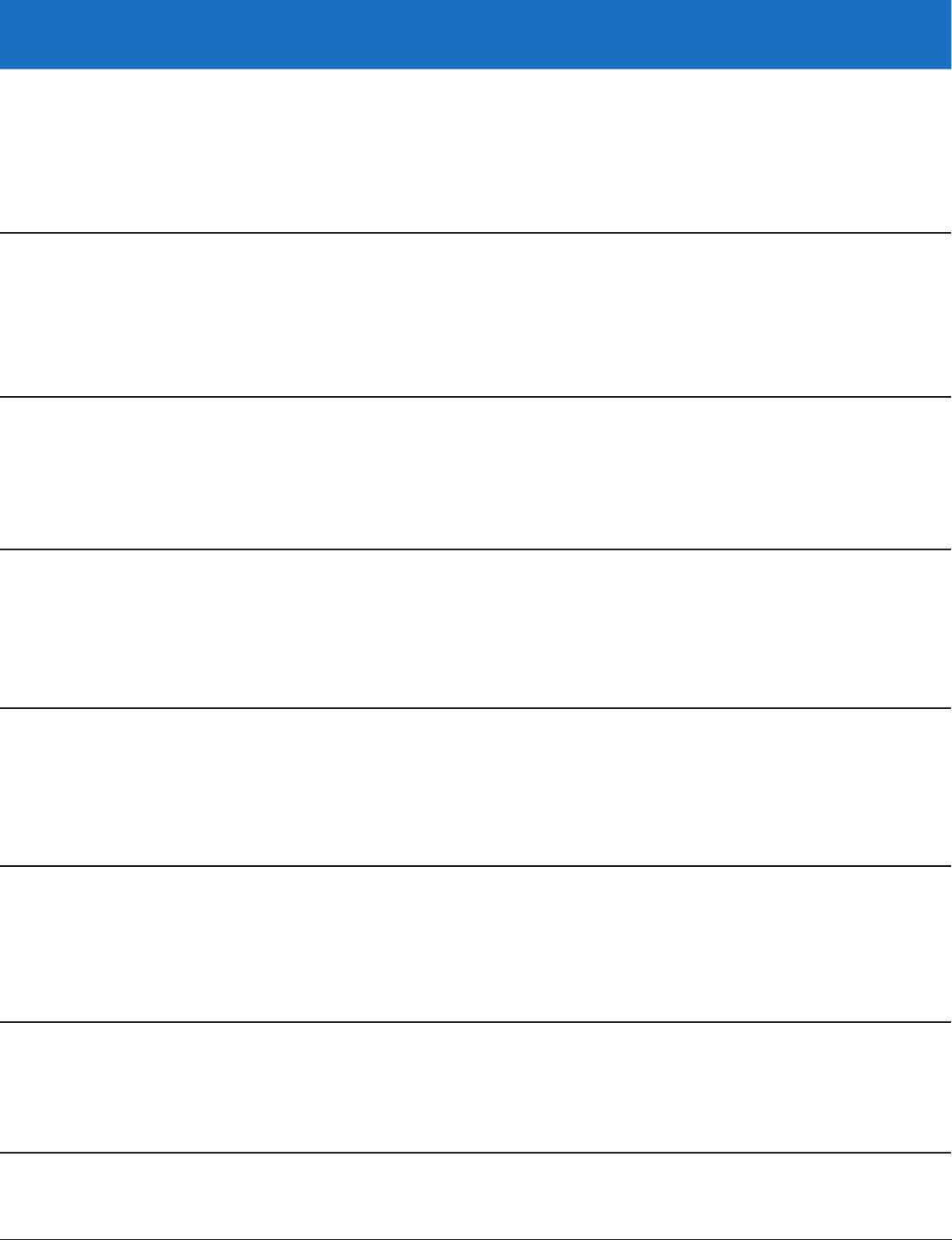
© 2021 Acadience Learning Inc. All Rights Reserved. Acadience is a registered trademark of Acadience Learning Inc.
8
Second Grade Benchmarks and Cut Points for Risk
Acadience
Reading
Measure
Benchmark
Status Likely Need for Support
Beginning
of Year
Middle
of Year
End
of Year
Reading
Composite
Score
Above Benchmark Likely to Need Core Support
a
202 + 256 + 287 +
At Benchmark Likely to Need Core Support
b
141 - 201 190 - 255 238 - 286
Below Benchmark Likely to Need Strategic Support
109 - 140 145 - 189 180 - 237
Well Below Benchmark Likely to Need Intensive Support
0 - 108 0 - 144 0 - 179
NWF-CLS
Above Benchmark Likely to Need Core Support
a
72 +
At Benchmark Likely to Need Core Support
b
54 - 71
Below Benchmark Likely to Need Strategic Support
35 - 53
Well Below Benchmark Likely to Need Intensive Support
0 - 34
NWF-WWR
Above Benchmark Likely to Need Core Support
a
21 +
At Benchmark Likely to Need Core Support
b
13 - 20
Below Benchmark Likely to Need Strategic Support
6 - 12
Well Below Benchmark Likely to Need Intensive Support
0 - 5
ORF
Words
Correct
Above Benchmark Likely to Need Core Support
a
68 + 91 + 104 +
At Benchmark Likely to Need Core Support
b
52 - 67 72 - 90 87 - 103
Below Benchmark Likely to Need Strategic Support
37 - 51 55 - 71 65 - 86
Well Below Benchmark Likely to Need Intensive Support
0 - 36 0 - 54 0 - 64
ORF
Accuracy
Above Benchmark Likely to Need Core Support
a
96% + 99% + 99% +
At Benchmark Likely to Need Core Support
b
90% - 95% 96% - 98% 97% - 98%
Below Benchmark Likely to Need Strategic Support
81% - 89% 91% - 95% 93% - 96%
Well Below Benchmark Likely to Need Intensive Support
0% - 80% 0% - 90% 0% - 92%
Retell
Above Benchmark Likely to Need Core Support
a
25 + 31 + 39 +
At Benchmark Likely to Need Core Support
b
16 - 24 21 - 30 27 - 38
Below Benchmark Likely to Need Strategic Support
8 - 15 13 - 20 18 - 26
Well Below Benchmark Likely to Need Intensive Support
0 - 7 0 - 12 0 - 17
Retell
Quality of
Response
At or Above Benchmark Likely to Need Core Support
b
2 + 2 +
Below Benchmark Likely to Need Strategic Support
1 1
Well Below Benchmark Likely to Need Intensive Support
The benchmark is the number that is bold. The cut point for risk is the number that is italicized.
a
Some students may benet from instruction on more advanced skills.
b
Some students may require monitoring and strategic support on component skills.
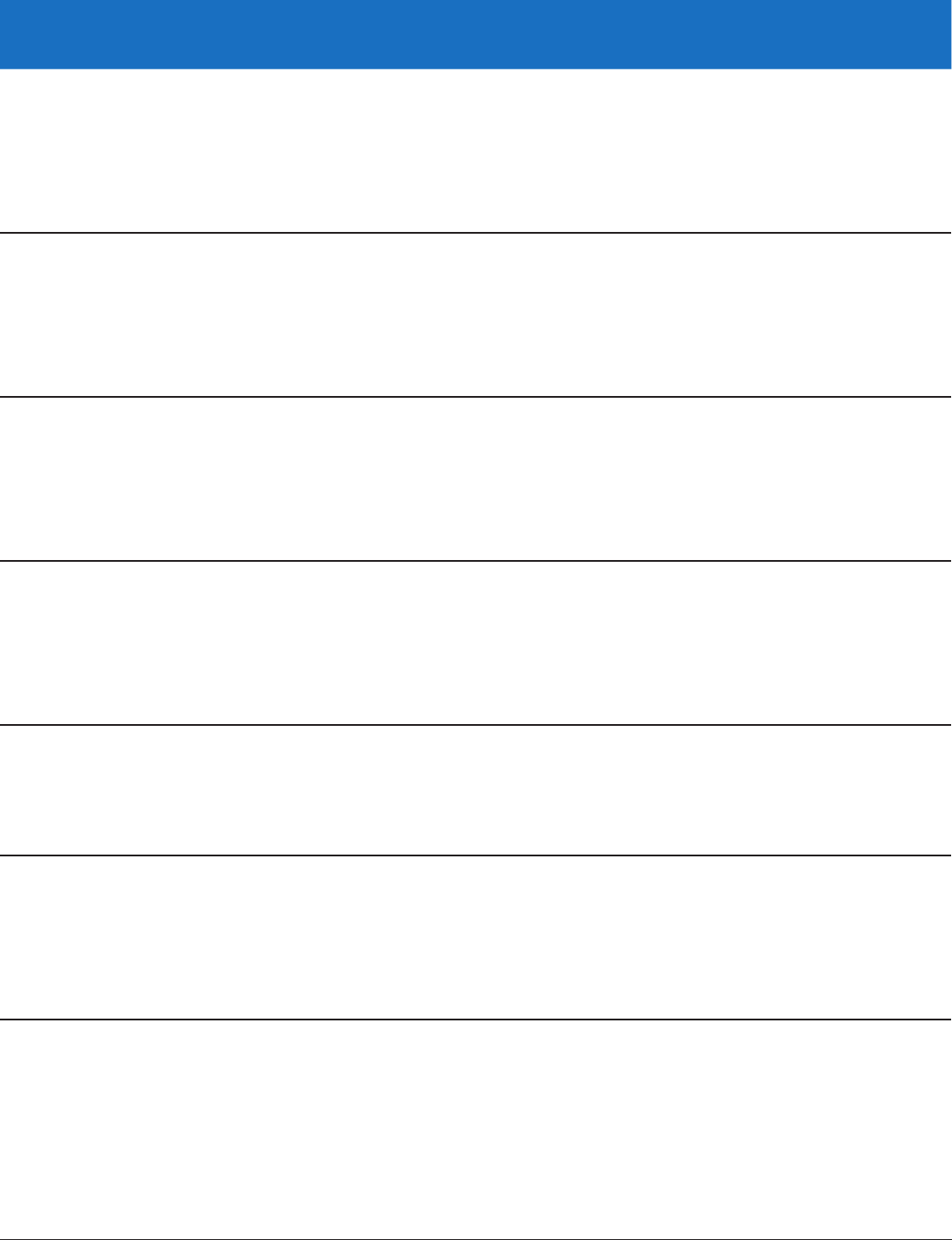
© 2021 Acadience Learning Inc. All Rights Reserved. Acadience is a registered trademark of Acadience Learning Inc.
9
Third Grade Benchmarks and Cut Points for Risk
Acadience
Reading
Measure
Benchmark
Status Likely Need for Support
Beginning
of Year
Middle
of Year
End
of Year
Reading
Composite
Score
Above Benchmark Likely to Need Core Support
a
289 + 349 + 405 +
At Benchmark Likely to Need Core Support
b
220 - 288 285 - 348 330 - 404
Below Benchmark Likely to Need Strategic Support
180 - 219 235 - 284 280 - 329
Well Below Benchmark Likely to Need Intensive Support
0 - 179 0 - 234 0 - 279
ORF
Words
Correct
Above Benchmark Likely to Need Core Support
a
90 + 105 + 118 +
At Benchmark Likely to Need Core Support
b
70 - 89 86 - 104 100 - 117
Below Benchmark Likely to Need Strategic Support
55 - 69 68 - 85 80 - 99
Well Below Benchmark Likely to Need Intensive Support
0 - 54 0 - 67 0 - 79
ORF
Accuracy
Above Benchmark Likely to Need Core Support
a
98% + 99% + 99% +
At Benchmark Likely to Need Core Support
b
95% - 97% 96% - 98% 97% - 98%
Below Benchmark Likely to Need Strategic Support
89% - 94% 92% - 95% 94% - 96%
Well Below Benchmark Likely to Need Intensive Support
0% - 88% 0% - 91% 0% - 93%
Retell
Above Benchmark Likely to Need Core Support
a
33 + 40 + 46 +
At Benchmark Likely to Need Core Support
b
20 - 32 26 - 39 30 - 45
Below Benchmark Likely to Need Strategic Support
10 - 19 18 - 25 20 - 29
Well Below Benchmark Likely to Need Intensive Support
0 - 9 0 - 17 0 - 19
Retell
Quality of
Response
At or Above Benchmark Likely to Need Core Support
b
2 + 2 + 3 +
Below Benchmark Likely to Need Strategic Support
1 1 2
Well Below Benchmark Likely to Need Intensive Support
1
Maze
Adjusted
Score
Above Benchmark Likely to Need Core Support
a
11 + 16 + 23 +
At Benchmark Likely to Need Core Support
b
8 - 10 11 - 15 19 - 22
Below Benchmark Likely to Need Strategic Support
5 - 7 7 - 10 14 - 18
Well Below Benchmark Likely to Need Intensive Support
0 - 4 0 - 6 0 - 13
The benchmark is the number that is bold. The cut point for risk is the number that is italicized.
a
Some students may benet from instruction on more advanced skills.
b
Some students may require monitoring and strategic support on component skills.
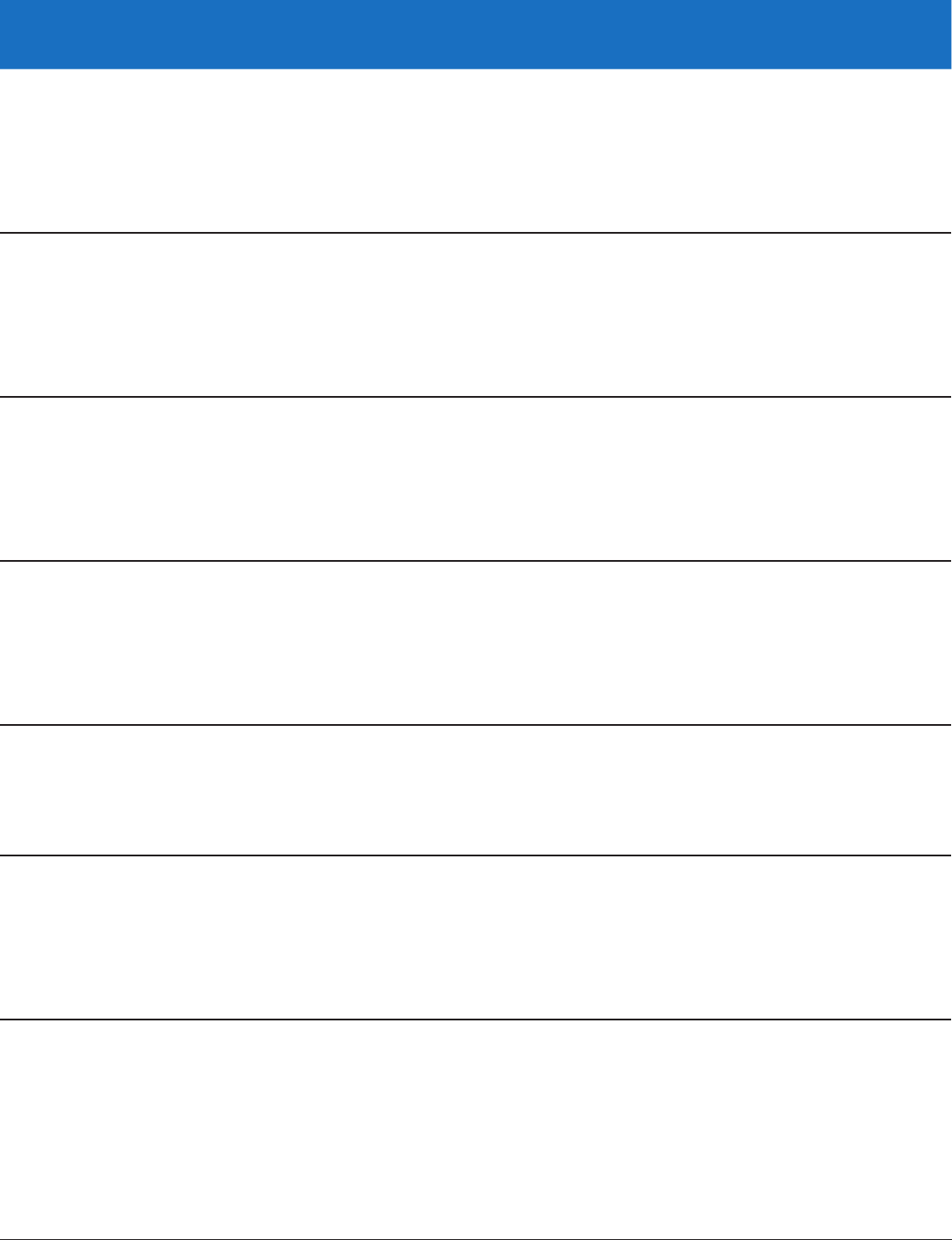
© 2021 Acadience Learning Inc. All Rights Reserved. Acadience is a registered trademark of Acadience Learning Inc.
10
Fourth Grade Benchmarks and Cut Points for Risk
Acadience
Reading
Measure
Benchmark
Status Likely Need for Support
Beginning
of Year
Middle
of Year
End
of Year
Reading
Composite
Score
Above Benchmark Likely to Need Core Support
a
341 + 383 + 446 +
At Benchmark Likely to Need Core Support
b
290 - 340 330 - 382 391 - 445
Below Benchmark Likely to Need Strategic Support
245 - 289 290 - 329 330 - 390
Well Below Benchmark Likely to Need Intensive Support
0 - 244 0 - 289 0 - 329
ORF
Words
Correct
Above Benchmark Likely to Need Core Support
a
104 + 121 + 133 +
At Benchmark Likely to Need Core Support
b
90 - 103 103 - 120 115 - 132
Below Benchmark Likely to Need Strategic Support
70 - 89 79 - 102 95 - 114
Well Below Benchmark Likely to Need Intensive Support
0 - 69 0 - 78 0 - 94
ORF
Accuracy
Above Benchmark Likely to Need Core Support
a
98% + 99% + 100% +
At Benchmark Likely to Need Core Support
b
96% - 97% 97% - 98% 98% - 99%
Below Benchmark Likely to Need Strategic Support
93% - 95% 94% - 96% 95% - 97%
Well Below Benchmark Likely to Need Intensive Support
0% - 92% 0% - 93% 0% - 94%
Retell
Above Benchmark Likely to Need Core Support
a
36 + 39 + 46 +
At Benchmark Likely to Need Core Support
b
27 - 35 30 - 38 33 - 45
Below Benchmark Likely to Need Strategic Support
14 - 26 20 - 29 24 - 32
Well Below Benchmark Likely to Need Intensive Support
0 - 13 0 - 19 0 - 23
Retell
Quality of
Response
At or Above Benchmark Likely to Need Core Support
b
2 + 2 + 3 +
Below Benchmark Likely to Need Strategic Support
1 1 2
Well Below Benchmark Likely to Need Intensive Support
1
Maze
Adjusted
Score
Above Benchmark Likely to Need Core Support
a
18 + 20 + 28 +
At Benchmark Likely to Need Core Support
b
15 - 17 17 - 19 24 - 27
Below Benchmark Likely to Need Strategic Support
10 - 14 12 - 16 20 - 23
Well Below Benchmark Likely to Need Intensive Support
0 - 9 0 - 11 0 - 19
The benchmark is the number that is bold. The cut point for risk is the number that is italicized.
a
Some students may benet from instruction on more advanced skills.
b
Some students may require monitoring and strategic support on component skills.
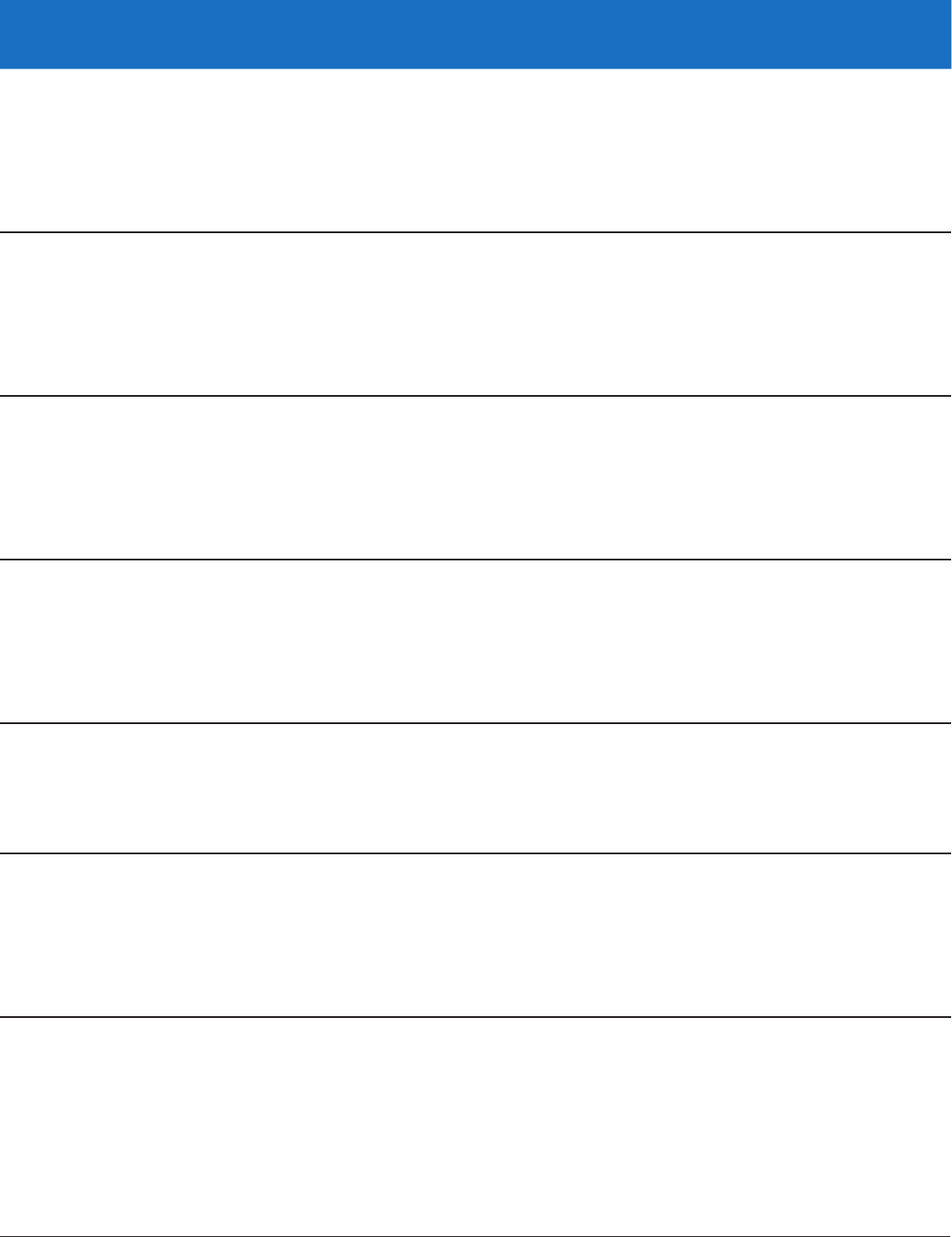
© 2021 Acadience Learning Inc. All Rights Reserved. Acadience is a registered trademark of Acadience Learning Inc.
11
Fifth Grade Benchmarks and Cut Points for Risk
Acadience
Reading
Measure
Benchmark
Status Likely Need for Support
Beginning
of Year
Middle
of Year
End
of Year
Reading
Composite
Score
Above Benchmark Likely to Need Core Support
a
386 + 411 + 466 +
At Benchmark Likely to Need Core Support
b
357 - 385 372 - 410 415 - 465
Below Benchmark Likely to Need Strategic Support
258 - 356 310 - 371 340 - 414
Well Below Benchmark Likely to Need Intensive Support
0 - 257 0 - 309 0 - 339
ORF
Words
Correct
Above Benchmark Likely to Need Core Support
a
121 + 133 + 143 +
At Benchmark Likely to Need Core Support
b
111 - 120 120 - 132 130 - 142
Below Benchmark Likely to Need Strategic Support
96 - 110 101 - 119 105 - 129
Well Below Benchmark Likely to Need Intensive Support
0 - 95 0 - 100 0 - 104
ORF
Accuracy
Above Benchmark Likely to Need Core Support
a
99% + 99% + 100%
At Benchmark Likely to Need Core Support
b
98% 98% 99%
Below Benchmark Likely to Need Strategic Support
95% - 97% 96% - 97% 97% - 98%
Well Below Benchmark Likely to Need Intensive Support
0% - 94% 0% - 95% 0% - 96%
Retell
Above Benchmark Likely to Need Core Support
a
40 + 46 + 52 +
At Benchmark Likely to Need Core Support
b
33 - 39 36 - 45 36 - 51
Below Benchmark Likely to Need Strategic Support
22 - 32 25 - 35 25 - 35
Well Below Benchmark Likely to Need Intensive Support
0 - 21 0 - 24 0 - 24
Retell
Quality of
Response
At or Above Benchmark Likely to Need Core Support
b
2 + 3 + 3 +
Below Benchmark Likely to Need Strategic Support
1 2 2
Well Below Benchmark Likely to Need Intensive Support
1 1
Maze
Adjusted
Score
Above Benchmark Likely to Need Core Support
a
21 + 21 + 28 +
At Benchmark Likely to Need Core Support
b
18 - 20 20 24 - 27
Below Benchmark Likely to Need Strategic Support
12 - 17 13 - 19 18 - 23
Well Below Benchmark Likely to Need Intensive Support
0 - 11 0 - 12 0 - 17
The benchmark is the number that is bold. The cut point for risk is the number that is italicized.
a
Some students may benet from instruction on more advanced skills.
b
Some students may require monitoring and strategic support on component skills.
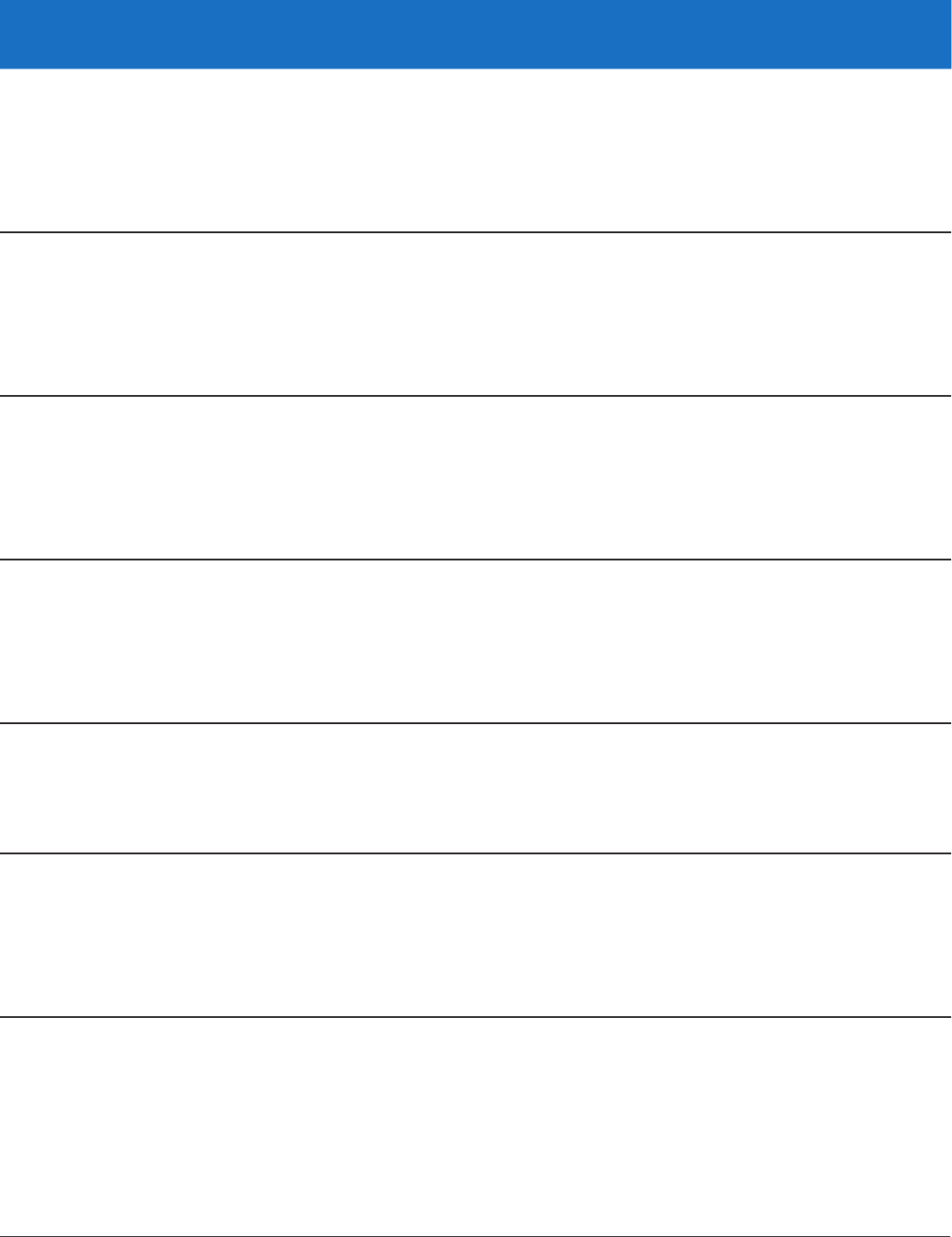
© 2021 Acadience Learning Inc. All Rights Reserved. Acadience is a registered trademark of Acadience Learning Inc.
12
Sixth Grade Benchmarks and Cut Points for Risk
Acadience
Reading
Measure
Benchmark
Status Likely Need for Support
Beginning
of Year
Middle
of Year
End
of Year
Reading
Composite
Score
Above Benchmark Likely to Need Core Support
a
435 + 461 + 478 +
At Benchmark Likely to Need Core Support
b
344 - 434 358 - 460 380 - 477
Below Benchmark Likely to Need Strategic Support
280 - 343 285 - 357 324 - 379
Well Below Benchmark Likely to Need Intensive Support
0 - 279 0 - 284 0 - 323
ORF
Words
Correct
Above Benchmark Likely to Need Core Support
a
139 + 141 + 151 +
At Benchmark Likely to Need Core Support
b
107 - 138 109 - 140 120 - 150
Below Benchmark Likely to Need Strategic Support
90 - 106 92 - 108 95 - 119
Well Below Benchmark Likely to Need Intensive Support
0 - 89 0 - 91 0 - 94
ORF
Accuracy
Above Benchmark Likely to Need Core Support
a
99% + 99% + 100%
At Benchmark Likely to Need Core Support
b
97% - 98% 97% - 98% 98% - 99%
Below Benchmark Likely to Need Strategic Support
94% - 96% 94% - 96% 96% - 97%
Well Below Benchmark Likely to Need Intensive Support
0% - 93% 0% - 93% 0% - 95%
Retell
Above Benchmark Likely to Need Core Support
a
43 + 48 + 50 +
At Benchmark Likely to Need Core Support
b
27 - 42 29 - 47 32 - 49
Below Benchmark Likely to Need Strategic Support
16 - 26 18 - 28 24 - 31
Well Below Benchmark Likely to Need Intensive Support
0 - 15 0 - 17 0 - 23
Retell
Quality of
Response
At or Above Benchmark Likely to Need Core Support
b
2 + 2 + 3 +
Below Benchmark Likely to Need Strategic Support
1 1 2
Well Below Benchmark Likely to Need Intensive Support
1
Maze
Adjusted
Score
Above Benchmark Likely to Need Core Support
a
27 + 30 + 30 +
At Benchmark Likely to Need Core Support
b
18 - 26 19 - 29 21 - 29
Below Benchmark Likely to Need Strategic Support
14 - 17 14 - 18 15 - 20
Well Below Benchmark Likely to Need Intensive Support
0 - 13 0 - 13 0 - 14
The benchmark is the number that is bold. The cut point for risk is the number that is italicized.
a
Some students may benet from instruction on more advanced skills.
b
Some students may require monitoring and strategic support on component skills.

© 2021 Acadience Learning Inc. All Rights Reserved. Acadience is a registered trademark of Acadience Learning Inc.
13
Kindergarten Percentage of Students Who Meet Later Outcomes on the Reading Composite
Score Based On Benchmark Status on Individual Acadience Reading Measures
Acadience
Reading
Measure
Benchmark
Status
Percent of students
At or Above
Benchmark on
middle-of-year
Reading Composite
Score based on
beginning-of-year
status
Percent of students
Above
Benchmark on
middle-of-year
Reading Composite
Score based on
beginning-of-year
status
Percent of students
At or Above
Benchmark on
end-of-year
Reading Composite
Score based on
middle-of-year
status
Percent of students
Above
Benchmark on
end-of-year
Reading Composite
Score based on
middle-of-year
status
Reading
Composite
Score
At or Above Benchmark 85% 58% 93% 59%
Above Benchmark 91% 67% 98% 77%
At Benchmark 70% 35% 85% 32%
Below Benchmark 54% 24% 56% 13%
Well Below Benchmark 32% 12% 18% 3%
FSF
At or Above Benchmark 83% 57% 86% 52%
Above Benchmark 88% 64% 93% 65%
At Benchmark 69% 36% 80% 41%
Below Benchmark 56% 26% 54% 19%
Well Below Benchmark 42% 18% 22% 5%
PSF
At or Above Benchmark – – 86% 52%
Above Benchmark – – 94% 66%
At Benchmark – – 79% 38%
Below Benchmark – – 53% 18%
Well Below Benchmark – – 26% 7%
NWF
Correct
Letter
Sounds
At or Above Benchmark – – 87% 53%
Above Benchmark – – 96% 72%
At Benchmark – – 78% 31%
Below Benchmark – – 47% 11 %
Well Below Benchmark – – 18% 4%
Note: This table shows the percent of students that are on track on the Reading Composite Score at the middle and end of the year
based on the student’s Acadience Reading measure score at the beginning and middle of the year. N = 441,923 students who had
Acadience Reading data for the 2013–2014 school year. Data exported from mCLASS
®
, VPORT
®
, and Acadience Data Management.
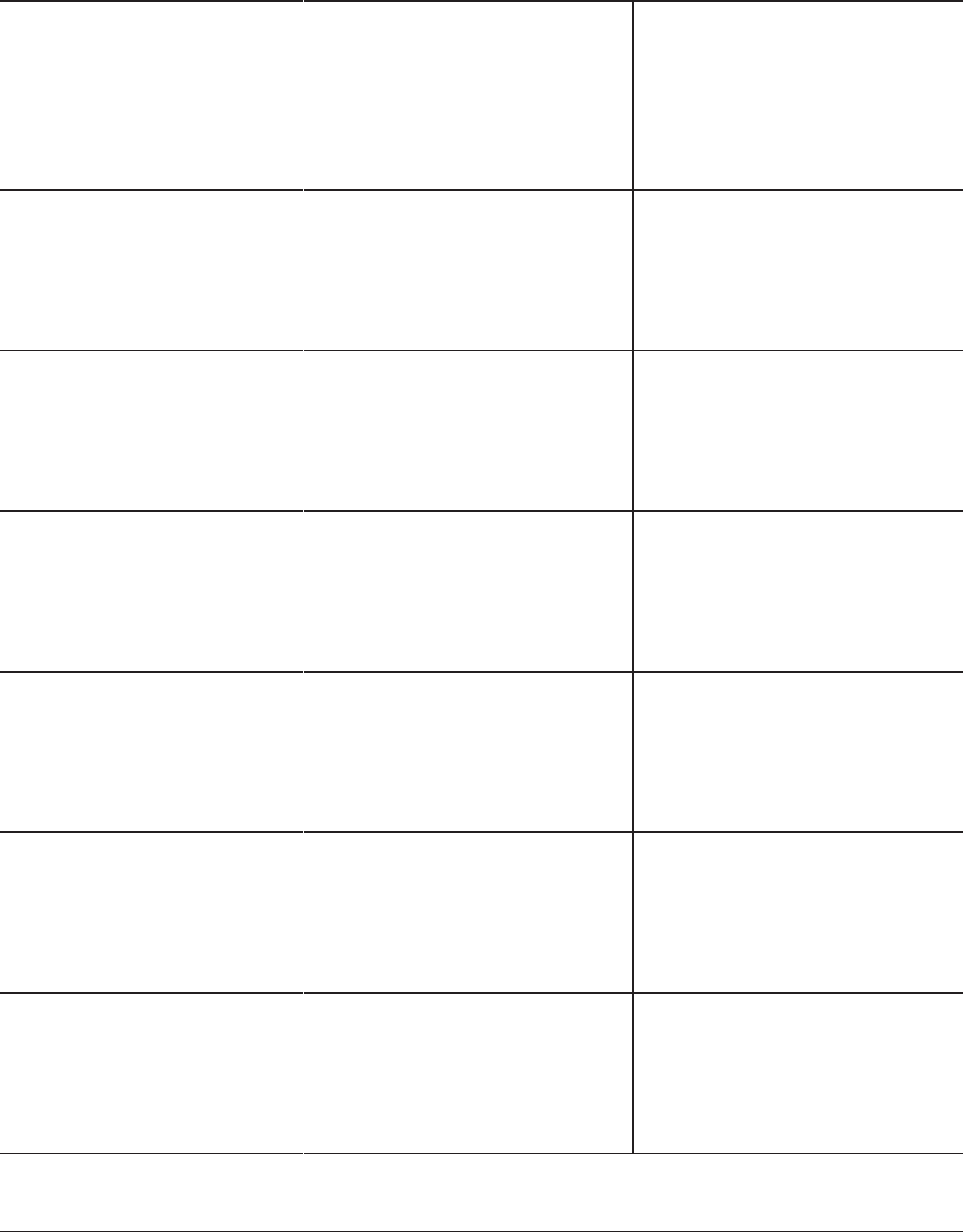
© 2021 Acadience Learning Inc. All Rights Reserved. Acadience is a registered trademark of Acadience Learning Inc.
14
First Grade Percentage of Students Who Meet Later Outcomes on the Reading Composite
Score Based On Benchmark Status on Individual Acadience Reading Measures
Acadience
Reading
Measure
Benchmark
Status
Percent of students
At or Above
Benchmark on
middle-of-year
Reading Composite
Score based on
beginning-of-year
status
Percent of students
Above
Benchmark on
middle-of-year
Reading Composite
Score based on
beginning-of-year
status
Percent of students
At or Above
Benchmark on
end-of-year
Reading Composite
Score based on
middle-of-year
status
Percent of students
Above
Benchmark on
end-of-year
Reading Composite
Score based on
middle-of-year
status
Reading
Composite
Score
At or Above Benchmark 87% 68% 92% 66%
Above Benchmark 93% 79% 99% 85%
At Benchmark 74% 44% 75% 20%
Below Benchmark 59% 29% 36% 5%
Well Below Benchmark 28% 11% 7% 1%
PSF
At or Above Benchmark 77% 56% – –
Above Benchmark 79% 59% – –
At Benchmark 74% 52% – –
Below Benchmark 64% 43% – –
Well Below Benchmark 36% 21% – –
NWF
Correct
Letter
Sounds
At or Above Benchmark 85% 66% 86% 63%
Above Benchmark 91% 77% 95% 81%
At Benchmark 68% 37% 67% 28%
Below Benchmark 49% 22% 43% 12%
Well Below Benchmark 22% 8% 18% 4%
NWF
Whole
Words
Read
At or Above Benchmark 83% 64% 83% 59%
Above Benchmark 92% 78% 96% 80%
At Benchmark 66% 36% 63% 25%
Below Benchmark 37% 16% 36% 10%
Well Below Benchmark – – 17% 5%
ORF
Words
Correct
At or Above Benchmark 91% 66%
Above Benchmark 98% 83%
At Benchmark 74% 24%
Below Benchmark 35% 6%
Well Below Benchmark 7% 1%
ORF
Accuracy
At or Above Benchmark 91% 67%
Above Benchmark 97% 80%
At Benchmark 74% 27%
Below Benchmark 43% 10%
Well Below Benchmark 9% 2%
Note: This table shows the percent of students that are on track on the Reading Composite Score at the middle and end of the year
based on the student’s Acadience Reading measure score at the beginning and middle of the year. N = 452,530 students who had
Acadience Reading data for the 2013–2014 school year. Data exported from mCLASS
®
, VPORT
®
, and Acadience Data Management.
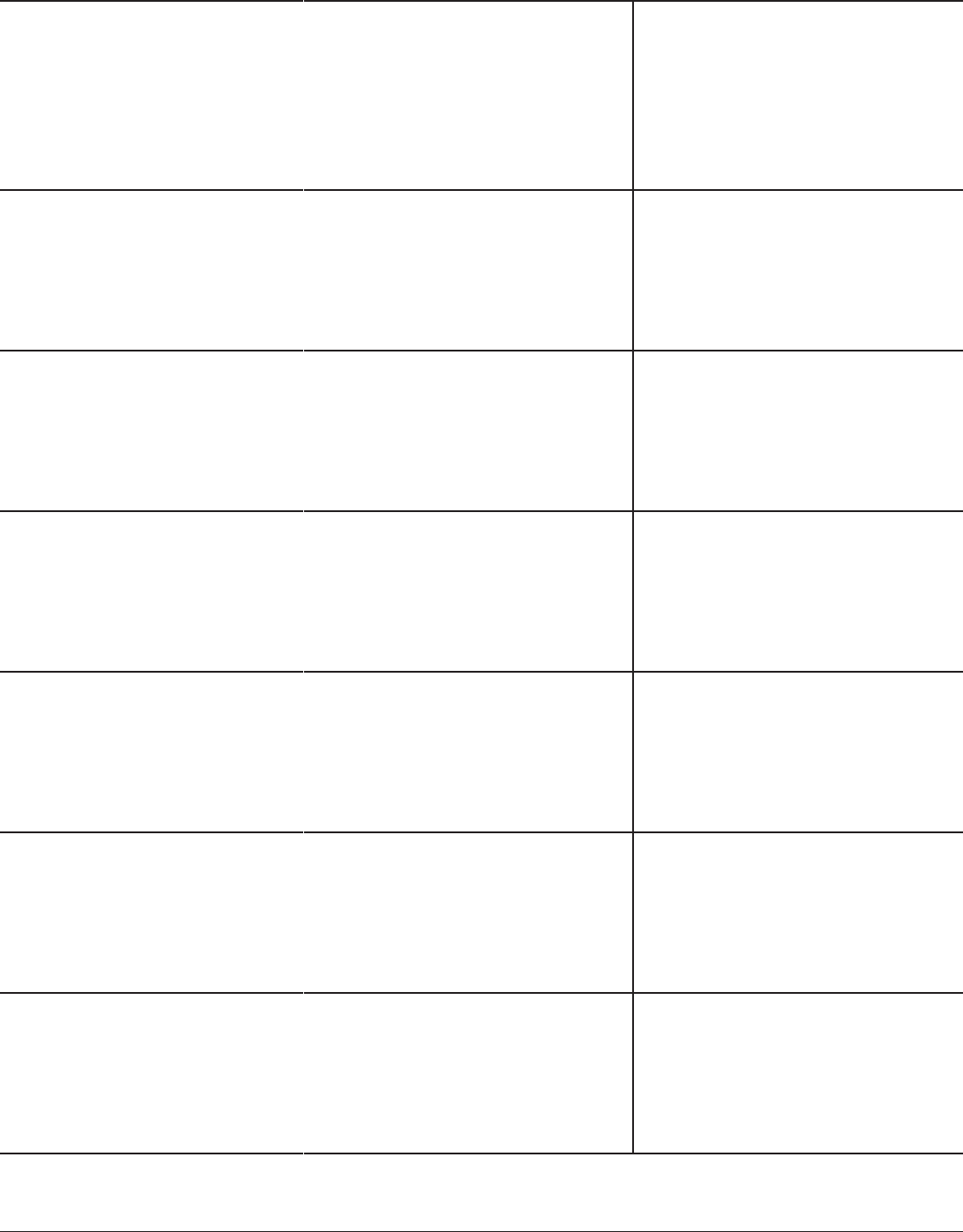
© 2021 Acadience Learning Inc. All Rights Reserved. Acadience is a registered trademark of Acadience Learning Inc.
15
Second Grade Percentage of Students Who Meet Later Outcomes on the Reading Composite
Score Based On Benchmark Status on Individual Acadience Reading Measures
Acadience
Reading
Measure
Benchmark
Status
Percent of students
At or Above
Benchmark on
middle-of-year
Reading Composite
Score based on
beginning-of-year
status
Percent of students
Above
Benchmark on
middle-of-year
Reading Composite
Score based on
beginning-of-year
status
Percent of students
At or Above
Benchmark on
end-of-year
Reading Composite
Score based on
middle-of-year
status
Percent of students
Above
Benchmark on
end-of-year
Reading Composite
Score based on
middle-of-year
status
Reading
Composite
Score
At or Above Benchmark 93% 64% 91% 64%
Above Benchmark 99% 83% 98% 84%
At Benchmark 85% 36% 77% 28%
Below Benchmark 46% 8% 35% 7%
Well Below Benchmark 11 % 1% 8% 1%
NWF
Correct
Letter
Sounds
At or Above Benchmark 92% 66% – –
Above Benchmark 96% 76% – –
At Benchmark 82% 46% – –
Below Benchmark 61% 26% – –
Well Below Benchmark 37% 13% – –
NWF
Whole
Words
Read
At or Above Benchmark 90% 64% – –
Above Benchmark 96% 76% – –
At Benchmark 80% 43% – –
Below Benchmark 57% 23% – –
Well Below Benchmark 36% 13% – –
ORF Words
Correct
At or Above Benchmark 96% 71% 94% 69%
Above Benchmark 99% 84% 98% 84%
At Benchmark 90% 42% 85% 40%
Below Benchmark 64% 15% 54% 15%
Well Below Benchmark 16% 2% 12% 2%
ORF
Accuracy
At or Above Benchmark 92% 63% 91% 65%
Above Benchmark 98% 79% 96% 77%
At Benchmark 82% 37% 81% 44%
Below Benchmark 45% 11% 44% 14%
Well Below Benchmark 11 % 2% 11% 4%
Retell
At or Above Benchmark 89% 63% 84% 60%
Above Benchmark 94% 74% 91% 72%
At Benchmark 80% 41% 71% 37%
Below Benchmark 62% 22% 48% 18%
Well Below Benchmark 33% 9% 24% 8%
Note: This table shows the percent of students that are on track on the Reading Composite Score at the middle and end of the year
based on the student’s Acadience Reading measure score at the beginning and middle of the year. N = 394,821 students who had
Acadience Reading data for the 2013–2014 school year. Data exported from mCLASS
®
, VPORT
®
, and Acadience Data Management.
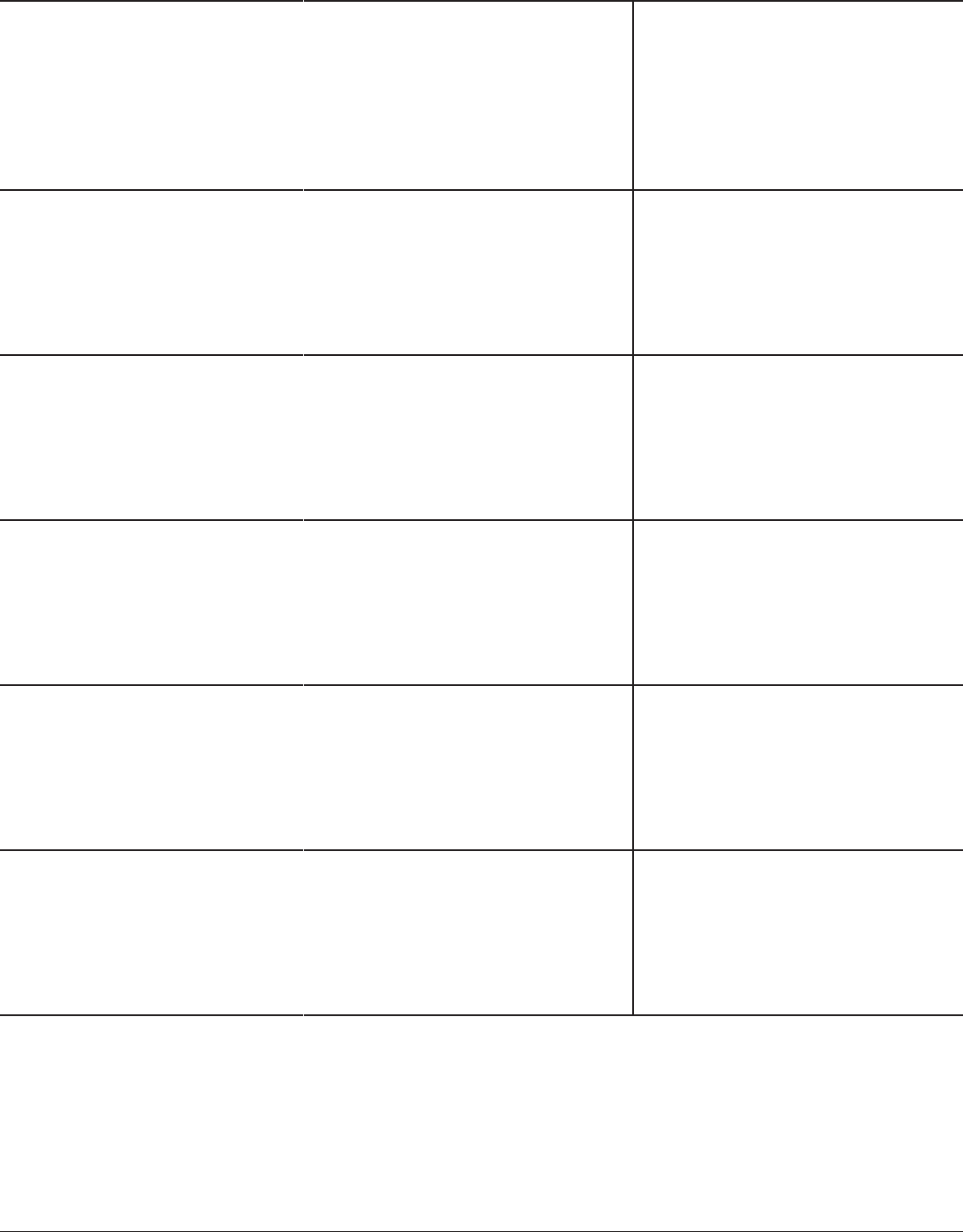
© 2021 Acadience Learning Inc. All Rights Reserved. Acadience is a registered trademark of Acadience Learning Inc.
16
Third Grade Percentage of Students Who Meet Later Outcomes on the Reading Composite
Score Based On Benchmark Status on Individual Acadience Reading Measures
Acadience
Reading
Measure
Benchmark
Status
Percent of students
At or Above
Benchmark on
middle-of-year
Reading Composite
Score based on
beginning-of-year
status
Percent of students
Above
Benchmark on
middle-of-year
Reading Composite
Score based on
beginning-of-year
status
Percent of students
At or Above
Benchmark on
end-of-year
Reading Composite
Score based on
middle-of-year
status
Percent of students
Above
Benchmark on
end-of-year
Reading Composite
Score based on
middle-of-year
status
Reading
Composite
Score
At or Above Benchmark 90% 62% 93% 64%
Above Benchmark 98% 82% 99% 84%
At Benchmark 76% 29% 83% 29%
Below Benchmark 43% 9% 46% 7%
Well Below Benchmark 12% 2% 9% 1%
ORF
Words
Correct
At or Above Benchmark 91% 64% 92% 65%
Above Benchmark 97% 82% 98% 83%
At Benchmark 79% 35% 83% 36%
Below Benchmark 49% 12% 50% 11%
Well Below Benchmark 14% 2% 12% 2%
ORF
Accuracy
At or Above Benchmark 87% 60% 85% 57%
Above Benchmark 94% 75% 92% 69%
At Benchmark 78% 42% 76% 39%
Below Benchmark 46% 16% 38% 11%
Well Below Benchmark 10% 3% 8% 2%
Retell
At or Above Benchmark 79% 53% 82% 55%
Above Benchmark 89% 68% 91% 69%
At Benchmark 65% 32% 69% 34%
Below Benchmark 39% 14% 46% 16%
Well Below Benchmark 22% 8% 25% 7%
Maze
Adjusted
Score
At or Above Benchmark 89% 65% 90% 65%
Above Benchmark 94% 76% 96% 78%
At Benchmark 78% 43% 80% 44%
Below Benchmark 58% 23% 58% 22%
Well Below Benchmark 29% 9% 26% 7%
Note: This table shows the percent of students that are on track on the Reading Composite Score at the middle and end of the year
based on the student’s Acadience Reading measure score at the beginning and middle of the year. N = 303,928 students who had
Acadience Reading data for the 2013–2014 school year. Data exported from mCLASS
®
, VPORT
®
, and Acadience Data Management.
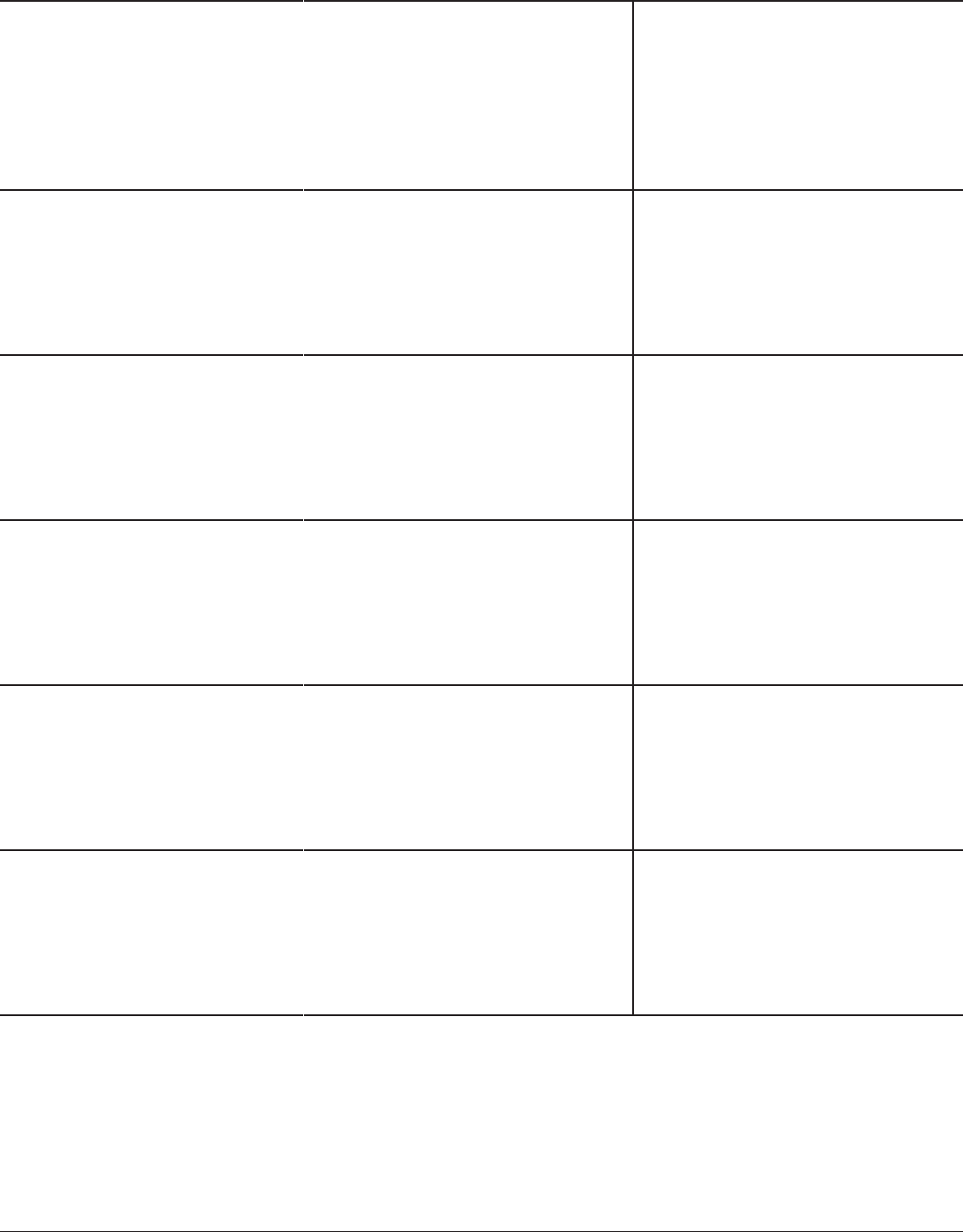
© 2021 Acadience Learning Inc. All Rights Reserved. Acadience is a registered trademark of Acadience Learning Inc.
17
Fourth Grade Percentage of Students Who Meet Later Outcomes on the Reading Composite
Score Based On Benchmark Status on Individual Acadience Reading Measures
Acadience
Reading
Measure
Benchmark
Status
Percent of students
At or Above
Benchmark on
middle-of-year
Reading Composite
Score based on
beginning-of-year
status
Percent of students
Above
Benchmark on
middle-of-year
Reading Composite
Score based on
beginning-of-year
status
Percent of students
At or Above
Benchmark on
end-of-year
Reading Composite
Score based on
middle-of-year
status
Percent of students
Above
Benchmark on
end-of-year
Reading Composite
Score based on
middle-of-year
status
Reading
Composite
Score
At or Above Benchmark 91% 68% 91% 65%
Above Benchmark 97% 84% 98% 83%
At Benchmark 76% 32% 77% 29%
Below Benchmark 45% 11% 45% 8%
Well Below Benchmark 9% 2% 9% 1%
ORF
Words
Correct
At or Above Benchmark 92% 72% 90% 66%
Above Benchmark 97% 82% 97% 82%
At Benchmark 79% 41% 76% 33%
Below Benchmark 54% 19% 42% 11%
Well Below Benchmark 12% 2% 7% 1%
ORF
Accuracy
At or Above Benchmark 82% 60% 80% 55%
Above Benchmark 89% 69% 88% 66%
At Benchmark 68% 39% 67% 35%
Below Benchmark 46% 20% 36% 12%
Well Below Benchmark 12% 4% 7% 2%
Retell
At or Above Benchmark 79% 58% 81% 57%
Above Benchmark 86% 68% 88% 66%
At Benchmark 63% 37% 66% 36%
Below Benchmark 40% 18% 45% 20%
Well Below Benchmark 17% 6% 19% 7%
Maze
Adjusted
Score
At or Above Benchmark 89% 68% 88% 67%
Above Benchmark 94% 78% 95% 79%
At Benchmark 73% 39% 75% 41%
Below Benchmark 47% 19% 50% 20%
Well Below Benchmark 14% 4% 18% 5%
Note: This table shows the percent of students that are on track on the Reading Composite Score at the middle and end of the year
based on the student’s Acadience Reading measure score at the beginning and middle of the year. N = 114,567 students who had
Acadience Reading data for the 2013–2014 school year. Data exported from mCLASS
®
, VPORT
®
, and Acadience Data Management.
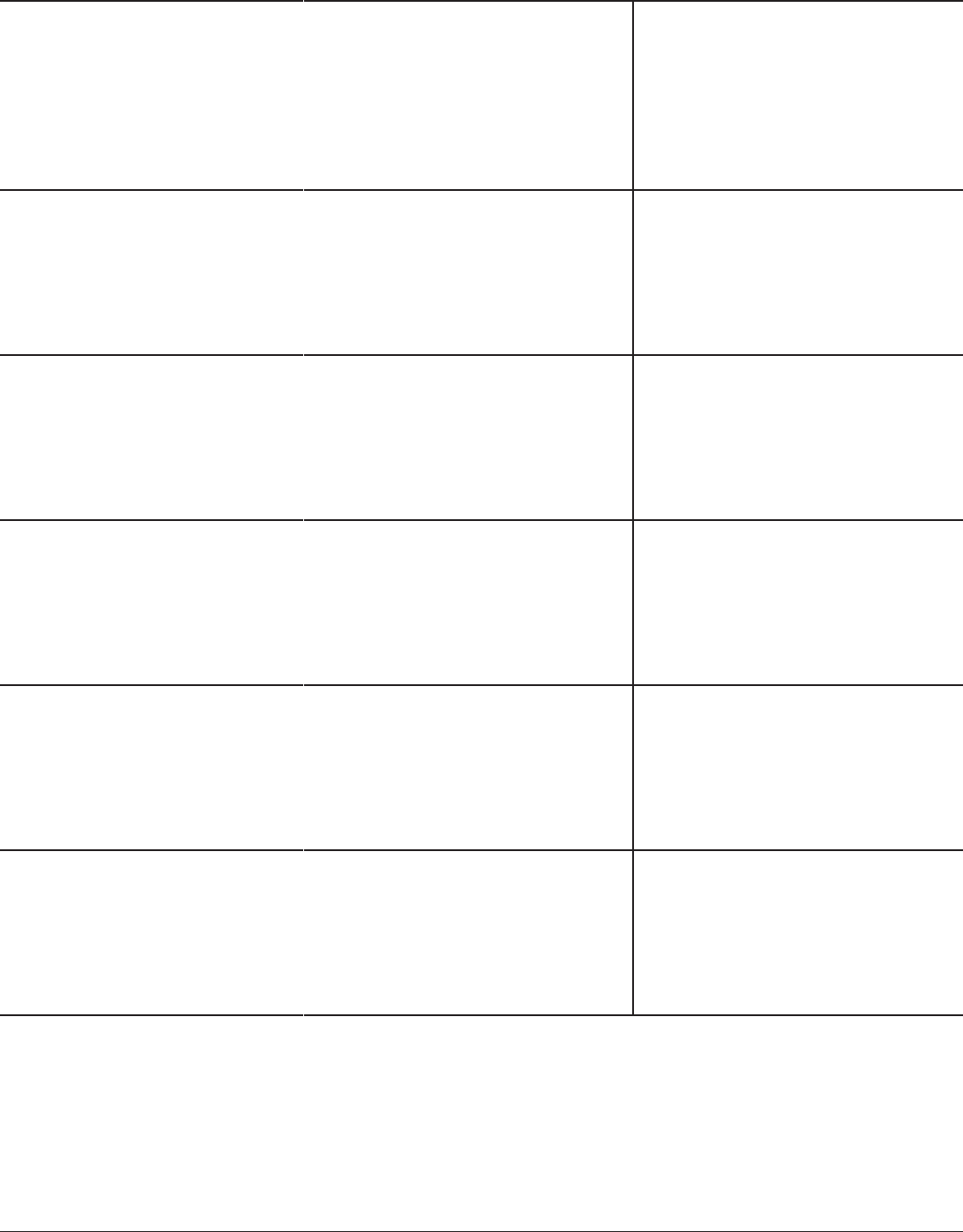
© 2021 Acadience Learning Inc. All Rights Reserved. Acadience is a registered trademark of Acadience Learning Inc.
18
Fifth Grade Percentage of Students Who Meet Later Outcomes on the Reading Composite
Score Based On Benchmark Status on Individual Acadience Reading Measures
Acadience
Reading
Measure
Benchmark
Status
Percent of students
At or Above
Benchmark on
middle-of-year
Reading Composite
Score based on
beginning-of-year
status
Percent of students
Above
Benchmark on
middle-of-year
Reading Composite
Score based on
beginning-of-year
status
Percent of students
At or Above
Benchmark on
end-of-year
Reading Composite
Score based on
middle-of-year
status
Percent of students
Above
Benchmark on
end-of-year
Reading Composite
Score based on
middle-of-year
status
Reading
Composite
Score
At or Above Benchmark 92% 76% 90% 68%
Above Benchmark 96% 84% 96% 82%
At Benchmark 75% 41% 73% 32%
Below Benchmark 37% 13% 35% 9%
Well Below Benchmark 3% 1% 3% 1%
ORF
Words
Correct
At or Above Benchmark 91% 76% 91% 72%
Above Benchmark 95% 83% 95% 81%
At Benchmark 75% 46% 76% 42%
Below Benchmark 56% 26% 47% 18%
Well Below Benchmark 16% 5% 8% 2%
ORF
Accuracy
At or Above Benchmark 80% 63% 76% 55%
Above Benchmark 89% 76% 88% 74%
At Benchmark 76% 57% 71% 48%
Below Benchmark 42% 22% 38% 18%
Well Below Benchmark 11 % 4% 10% 4%
Retell
At or Above Benchmark 76% 59% 75% 55%
Above Benchmark 82% 67% 83% 66%
At Benchmark 60% 39% 59% 34%
Below Benchmark 42% 23% 39% 19%
Well Below Benchmark 18% 9% 17% 7%
Maze
Adjusted
Score
At or Above Benchmark 86% 69% 91% 74%
Above Benchmark 91% 78% 92% 77%
At Benchmark 67% 41% 77% 48%
Below Benchmark 45% 22% 52% 25%
Well Below Benchmark 15% 6% 14% 4%
Note: This table shows the percent of students that are on track on the Reading Composite Score at the middle and end of the year
based on the student’s Acadience Reading measure score at the beginning and middle of the year. N = 98,565 students who had
Acadience Reading data for the 2013–2014 school year. Data exported from mCLASS
®
, VPORT
®
, and Acadience Data Management.
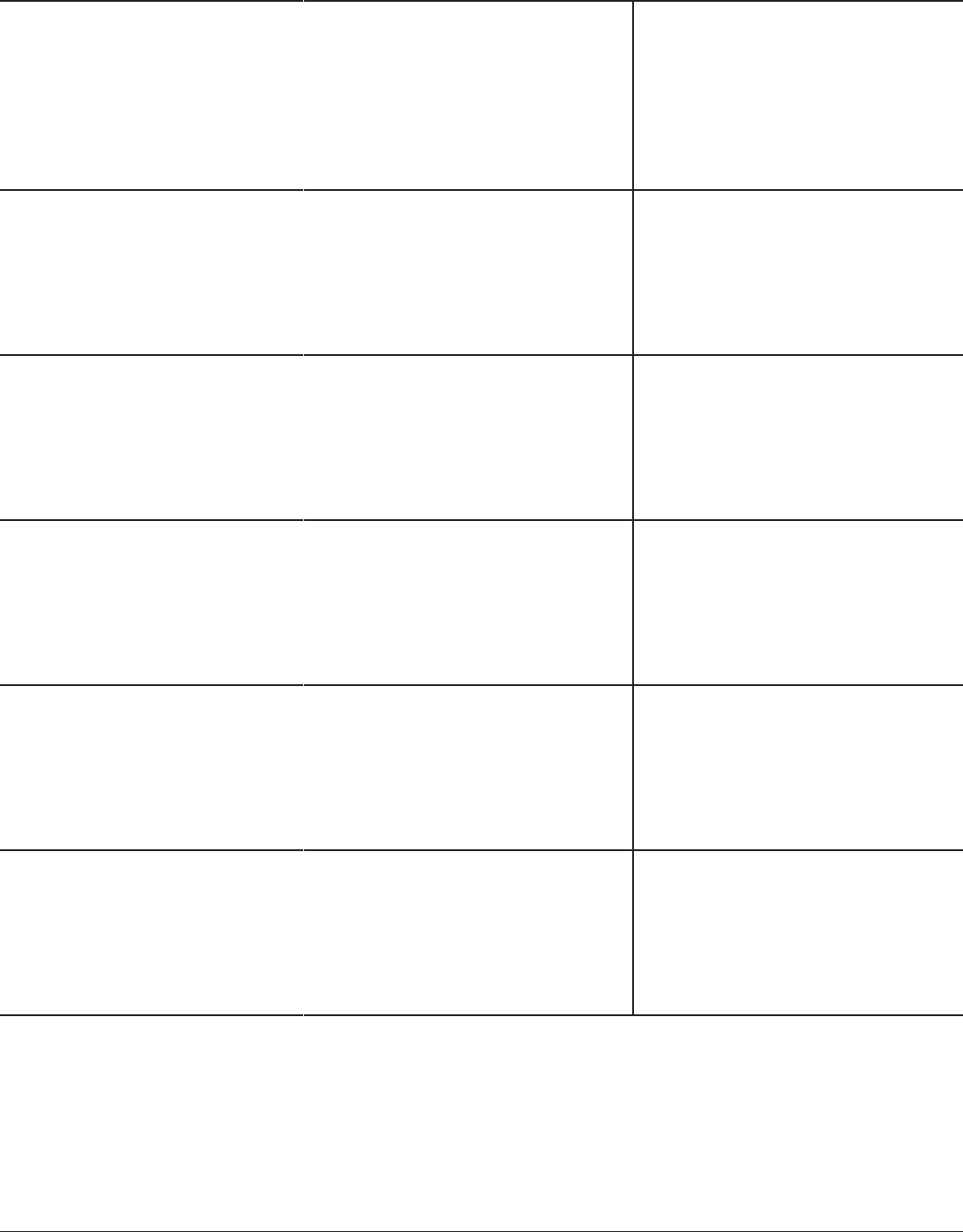
© 2021 Acadience Learning Inc. All Rights Reserved. Acadience is a registered trademark of Acadience Learning Inc.
19
Sixth Grade Percentage of Students Who Meet Later Outcomes on the Reading Composite
Score Based On Benchmark Status on Individual Acadience Reading Measures
Acadience
Reading
Measure
Benchmark
Status
Percent of students
At or Above
Benchmark on
middle-of-year
Reading Composite
Score based on
beginning-of-year
status
Percent of students
Above
Benchmark on
middle-of-year
Reading Composite
Score based on
beginning-of-year
status
Percent of students
At or Above
Benchmark on
end-of-year
Reading Composite
Score based on
middle-of-year
status
Percent of students
Above
Benchmark on
end-of-year
Reading Composite
Score based on
middle-of-year
status
Reading
Composite
Score
At or Above Benchmark 93% 54% 94% 55%
Above Benchmark 99% 82% 100% 83%
At Benchmark 85% 20% 87% 21%
Below Benchmark 32% 2% 35% 1%
Well Below Benchmark 3% 0% 3% 0%
ORF
Words
Correct
At or Above Benchmark 92% 55% 93% 56%
Above Benchmark 99% 80% 99% 80%
At Benchmark 85% 26% 85% 27%
Below Benchmark 44% 3% 50% 5%
Well Below Benchmark 8% 0% 11% 1%
ORF
Accuracy
At or Above Benchmark 86% 49% 86% 50%
Above Benchmark 92% 61% 94% 66%
At Benchmark 83% 45% 83% 43%
Below Benchmark 46% 12% 46% 10%
Well Below Benchmark 9% 2% 10% 1%
Retell
At or Above Benchmark 85% 50% 86% 51%
Above Benchmark 93% 65% 95% 68%
At Benchmark 75% 33% 76% 31%
Below Benchmark 52% 15% 49% 10%
Well Below Benchmark 26% 5% 21% 3%
Maze
Adjusted
Score
At or Above Benchmark 89% 51% 90% 53%
Above Benchmark 98% 77% 99% 78%
At Benchmark 78% 24% 81% 27%
Below Benchmark 36% 4% 43% 6%
Well Below Benchmark 13% 2% 12% 1%
Note: This table shows the percent of students that are on track on the Reading Composite Score at the middle and end of the year
based on the student’s Acadience Reading measure score at the beginning and middle of the year. N = 32,337 students who had
Acadience Reading data for the 2013–2014 school year. Data exported from mCLASS
®
, VPORT
®
, and Acadience Data Management.
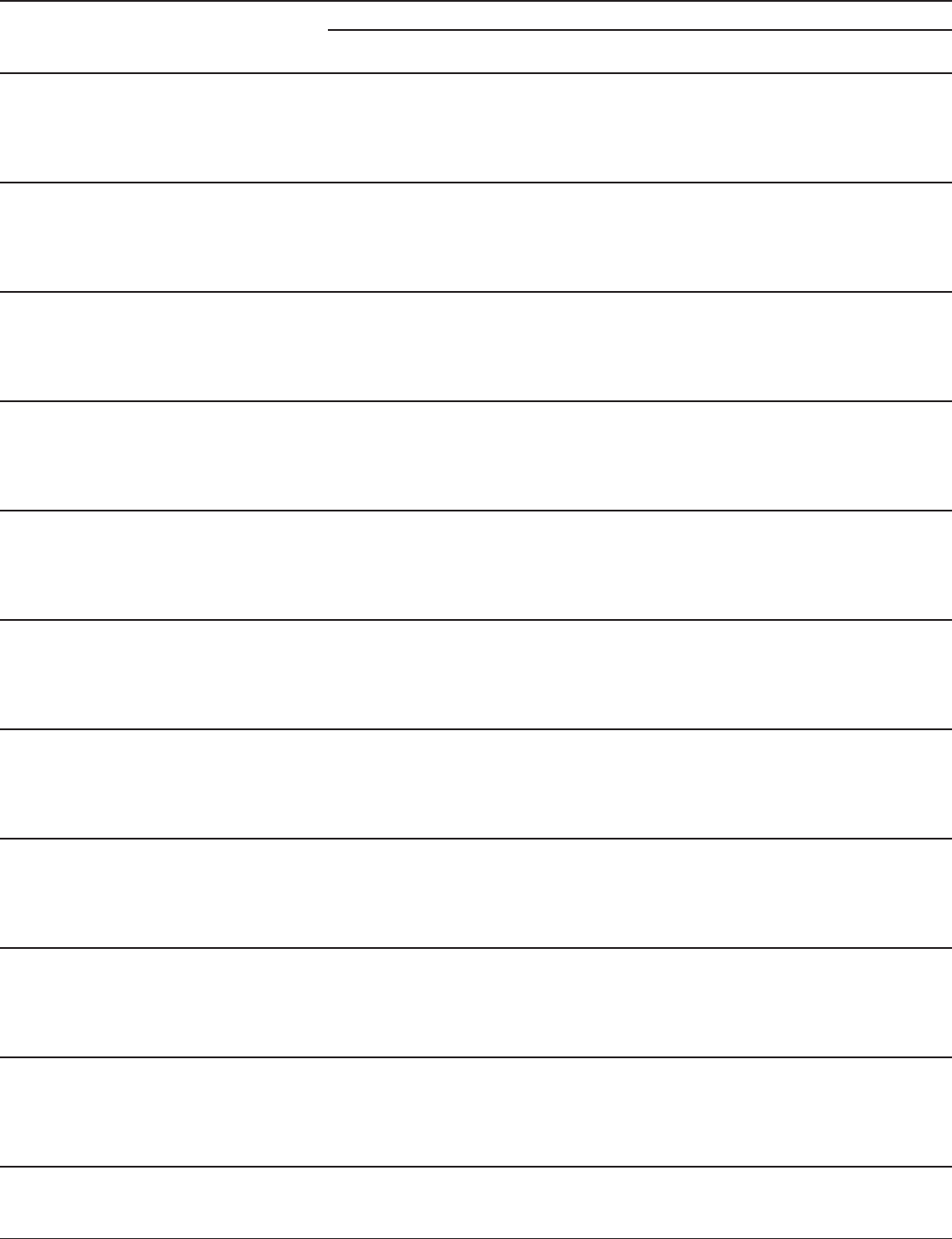
© 2021 Acadience Learning Inc. All Rights Reserved. Acadience is a registered trademark of Acadience Learning Inc.
20
Percent of Students Who Met Outcomes on the GRADE
Acadience
Reading
Measure
End-of-Year
Benchmark Status
Likelihood of Being on Track on the GRADE by Grade Level
K 1 2 3 4 5 6
Reading
Composite
Score
At or Above Benchmark 74% 90% 89% 90% 84% 87% 93%
Below Benchmark 50% 48% 45% 48% 58% 45% 45%
Well Below Benchmark 36% 10% 14% 7% 3% 7% 13%
FSF
At or Above Benchmark 70%
Below Benchmark 56%
Well Below Benchmark 50%
PSF
At or Above Benchmark 74% 83%
Below Benchmark 63% 59%
Well Below Benchmark 20% 32%
NWF
Correct
Letter
Sounds
At or Above Benchmark 90%
Below Benchmark 42%
Well Below Benchmark 10%
NWF
Whole
Words
Read
At or Above Benchmark 89%
Below Benchmark 36%
Well Below Benchmark 13%
ORF
Words
Correct
At or Above Benchmark 87% 89% 89% 85% 83% 90%
Below Benchmark 62% 43% 50% 59% 57% 64%
Well Below Benchmark 14% 18% 3% 11% 25%
ORF
Accuracy
At or Above Benchmark 88% 87% 75% 82% 90%
Below Benchmark 39% 38% 54% 55% 69%
Well Below Benchmark 26% 19% 6% 16% 30%
Retell
At or Above Benchmark 86% 86% 83% 86% 90%
Below Benchmark 56% 48% 53% 39% 60%
Well Below Benchmark 19% 20% 12% 20% 25%
Retell
Quality of
Response
At or Above Benchmark 81% 87% 87% 83% 92%
Below Benchmark 41% 60% 52% 38% 68%
Well Below Benchmark 15% 19% 11% 25%
Maze
Adjusted
Score
At or Above Benchmark 90% 80% 82% 90%
Below Benchmark 48% 65% 61% 57%
Well Below Benchmark 14% 14% 20% 20%
Note: This table shows the likelihood of being on track on the GRADE assessment administered at the end of the year, based on the
student’s individual end-of-year Acadience Reading measure benchmark status. The 40th percentile for the GRADE assessment was
used to indicate whether the student was on track.
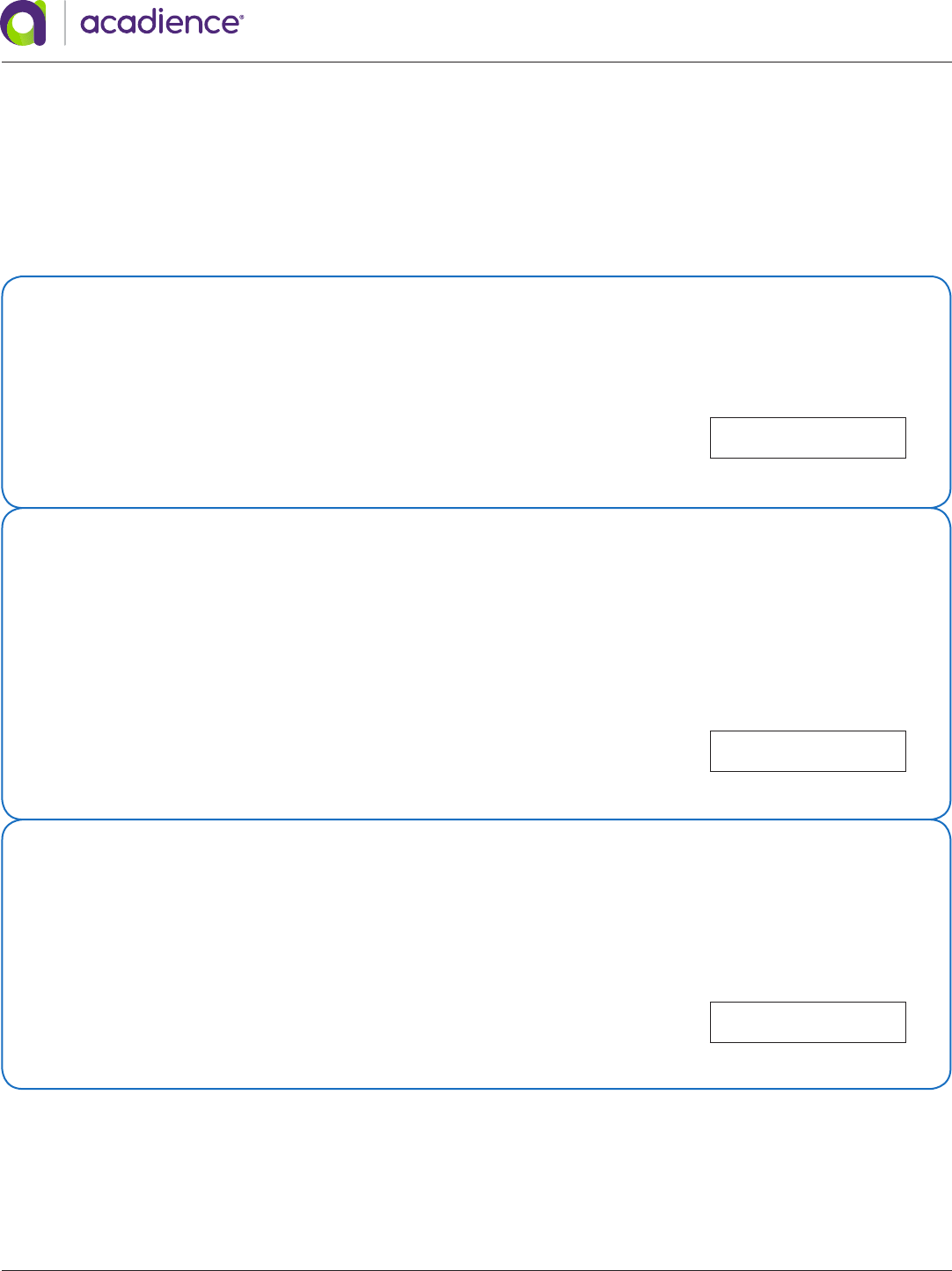
© 2021 Acadience Learning Inc. All Rights Reserved. Acadience is a registered trademark of Acadience Learning Inc.
21
The Acadience Reading Composite Score is used to interpret student results for Acadience Reading. Most data management services
will calculate the composite score for you. If you do not use a data management service or if your data management service does not
calculate it, you can use this worksheet to calculate the composite score.
Name: _____________________________________ Class: _____________________________________
Kindergarten Reading Composite Score Worksheet
© Acadience Learning Inc. / March 11, 2021
reading k–6
Beginning of Year Benchmark
FSF Score = ___________________ [1]
LNF Score = ___________________ [2]
Acadience Reading Composite Score (add values 1–2) =
Do not calculate the composite score if any of the values are missing.
Middle of Year Benchmark
FSF Score = ___________________ [1]
LNF Score = ___________________ [2]
PSF Score = ___________________ [3]
NWF CLS Score = ___________________ [4]
Acadience Reading Composite Score (add values 1–4) =
Do not calculate the composite score if any of the values are missing.
End of Year Benchmark
LNF Score = ___________________ [1]
PSF Score = ___________________ [2]
NWF CLS Score = ___________________ [3]
Acadience Reading Composite Score (add values 1–3) =
Do not calculate the composite score if any of the values are missing.
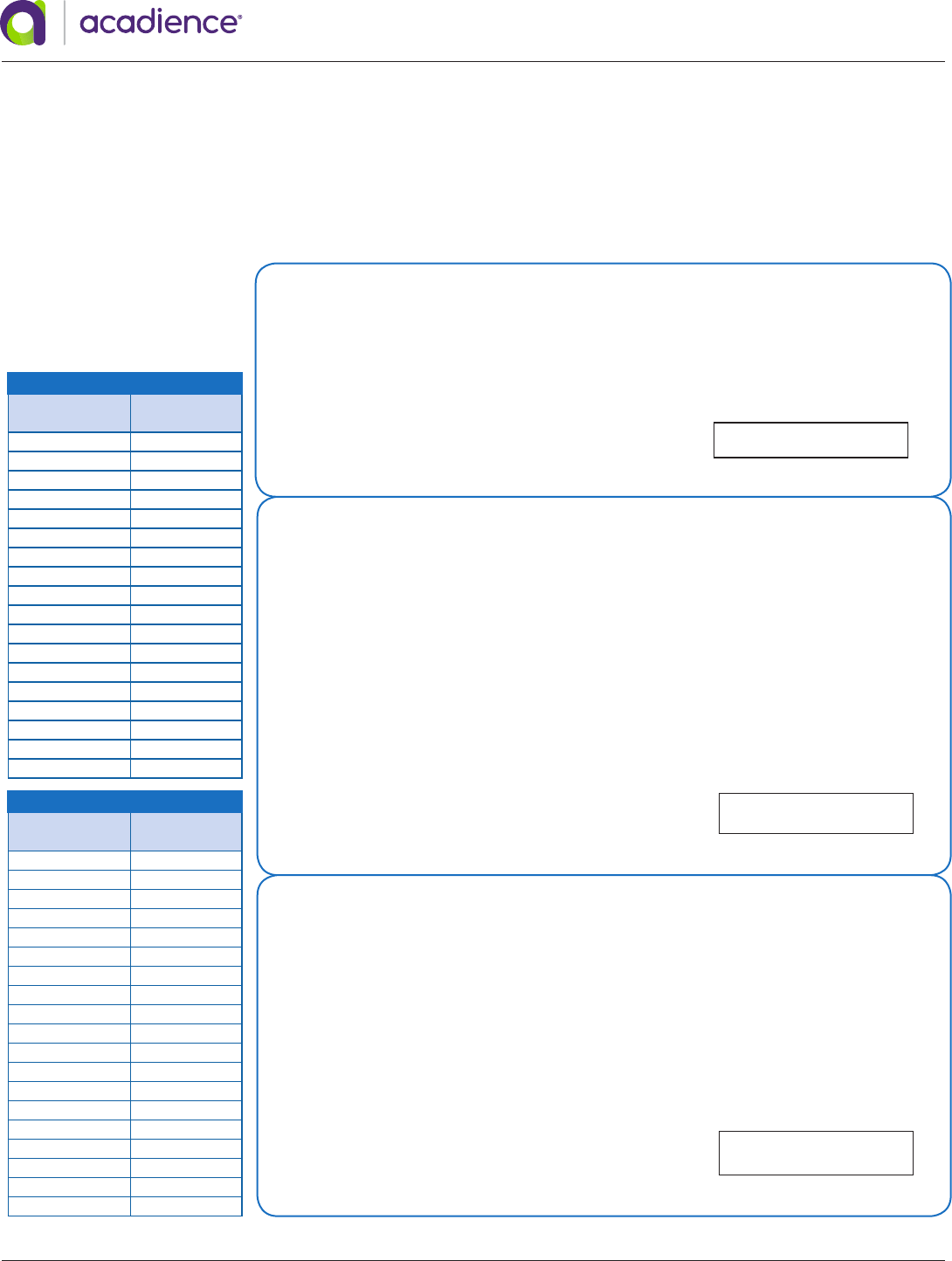
© 2021 Acadience Learning Inc. All Rights Reserved. Acadience is a registered trademark of Acadience Learning Inc.
22
The Acadience Reading Composite Score is used to interpret student results for Acadience Reading. Most data management services
will calculate the composite score for you. If you do not use a data management service or if your data management service does not
calculate it, you can use this worksheet to calculate the composite score.
Name: _____________________________________ Class: _____________________________________
First Grade Reading Composite Score Worksheet
© Acadience Learning Inc. / March 11, 2021
reading k–6
Middle of Year
ORF Accuracy
Percent
Accuracy
Value
0% – 49% 0
50% – 52% 2
53% – 55% 8
56% – 58% 14
59% – 61% 20
62% – 64% 26
65% – 67% 32
68% – 70% 38
71% – 73% 44
74% – 76% 50
77% – 79% 56
80% – 82% 62
83% – 85% 68
86% – 88% 74
89% – 91% 80
92% – 94% 86
95% – 97% 92
98% – 100% 98
End of Year
ORF Accuracy
Percent
Accuracy
Value
0% – 64% 0
65% – 66% 3
67% – 68% 9
69% – 70% 15
71% – 72% 21
73% – 74% 27
75% – 76% 33
77% – 78% 39
79% – 80% 45
81% – 82% 51
83% – 84% 57
85% – 86% 63
87% – 88% 69
89% – 90% 75
91% – 92% 81
93% – 94% 87
95% – 96% 93
97% – 98% 99
99% – 100% 105
Middle of Year Benchmark
NWF CLS Score = ___________________ [1]
NWF WWR Score = ___________________ [2]
ORF Words Correct = ___________________ [3]
ORF Accuracy Percent: _________ %
100 x (Words Correct / (Words Correct + Errors))
Accuracy Value from Table = ___________________ [4]
Acadience Reading Composite Score (add values 1–4)
=
Do not calculate the composite score if any of the values are missing.
End of Year Benchmark
NWF WWR Score ___________ x 2 = ___________________ [1]
ORF Words Correct = ___________________ [2]
ORF Accuracy Percent: _________ %
100 x (Words Correct / (Words Correct + Errors))
Accuracy Value from Table = ___________________ [3]
Acadience Reading Composite Score (add values 1–3)
=
Do not calculate the composite score if any of the values are missing.
Beginning of Year Benchmark
LNF Score = ___________________ [1]
PSF Score = ___________________ [2]
NWF CLS Score = ___________________ [3]
Acadience Reading Composite Score (add values 1–3)
=
Do not calculate the composite score if any of the values are missing.
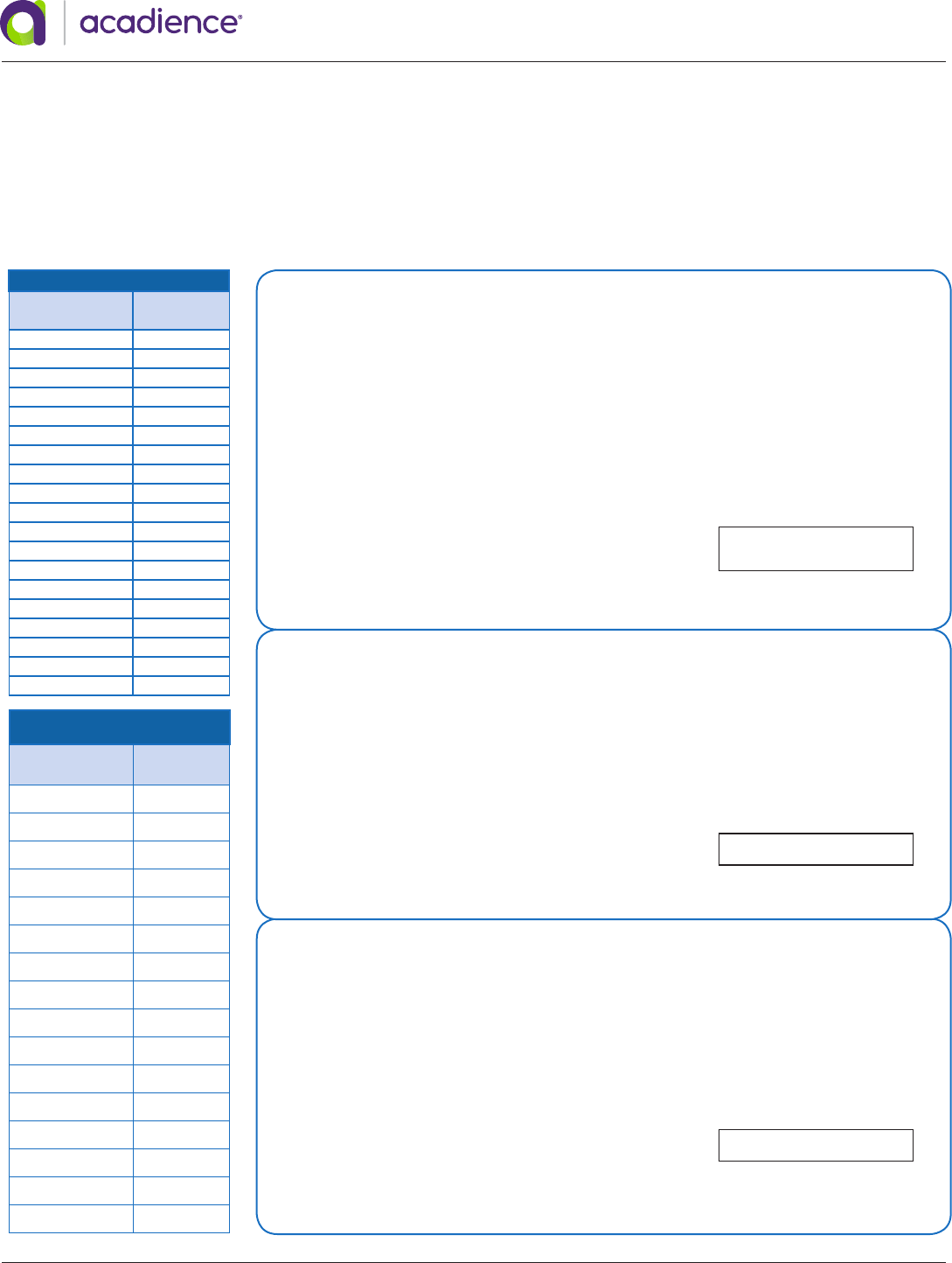
© 2021 Acadience Learning Inc. All Rights Reserved. Acadience is a registered trademark of Acadience Learning Inc.
23
The Acadience Reading Composite Score is used to interpret student results for Acadience Reading. Most data management services
will calculate the composite score for you. If you do not use a data management service or if your data management service does not
calculate it, you can use this worksheet to calculate the composite score.
Name: _____________________________________ Class: _____________________________________
Second Grade Reading Composite Score Worksheet
© Acadience Learning Inc. / March 11, 2021
reading k–6
End of Year Benchmark
ORF Words Correct = ___________________ [1]
Retell Score ___________ x 2 = ___________________ [2]
ORF Accuracy Percent: _________ %
100 x (Words Correct / (Words Correct + Errors))
Accuracy Value from Table = ___________________ [3]
Acadience Reading Composite Score (add values 1–3)
=
If ORF is below 40 and Retell is not administered, use 0 for the Retell value only for calculating the Acadience
Reading Composite Score. Do not calculate the composite score if any of the values are missing.
Middle of Year Benchmark
ORF Words Correct = ___________________ [1]
Retell Score ___________ x 2 = ___________________ [2]
ORF Accuracy Percent: _________ %
100 x (Words Correct / (Words Correct + Errors))
Accuracy Value from Table = ___________________ [3]
Acadience Reading Composite Score (add values 1–3)
=
If ORF is below 40 and Retell is not administered, use 0 for the Retell value only for calculating the Acadience
Reading Composite Score. Do not calculate the composite score if any of the values are missing.
Beginning of Year Benchmark
NWF WWR Score ___________ x 2 = ___________________ [1]
ORF Words Correct = ___________________ [2]
ORF Accuracy Percent: _________ %
100 x (Words Correct / (Words Correct + Errors))
Accuracy Value from Table = ___________________ [3]
Acadience Reading Composite Score (add values 1–3)
=
Do not calculate the composite score if any of the values are missing.
Beginning of Year
ORF Accuracy
Percent
Accuracy
Value
0% – 64% 0
65% – 66% 3
67% – 68% 9
69% – 70% 15
71% – 72% 21
73% – 74% 27
75% – 76% 33
77% – 78% 39
79% – 80% 45
81% – 82% 51
83% – 84% 57
85% – 86% 63
87% – 88% 69
89% – 90% 75
91% – 92% 81
93% – 94% 87
95% – 96% 93
97% – 98% 99
99% – 100% 105
Middle and End of Year
ORF Accuracy
Percent
Accuracy
Value
0% – 85% 0
86% 8
87% 16
88% 24
89% 32
90% 40
91% 48
92% 56
93% 64
94% 72
95% 80
96% 88
97% 96
98% 104
99% 112
100% 120
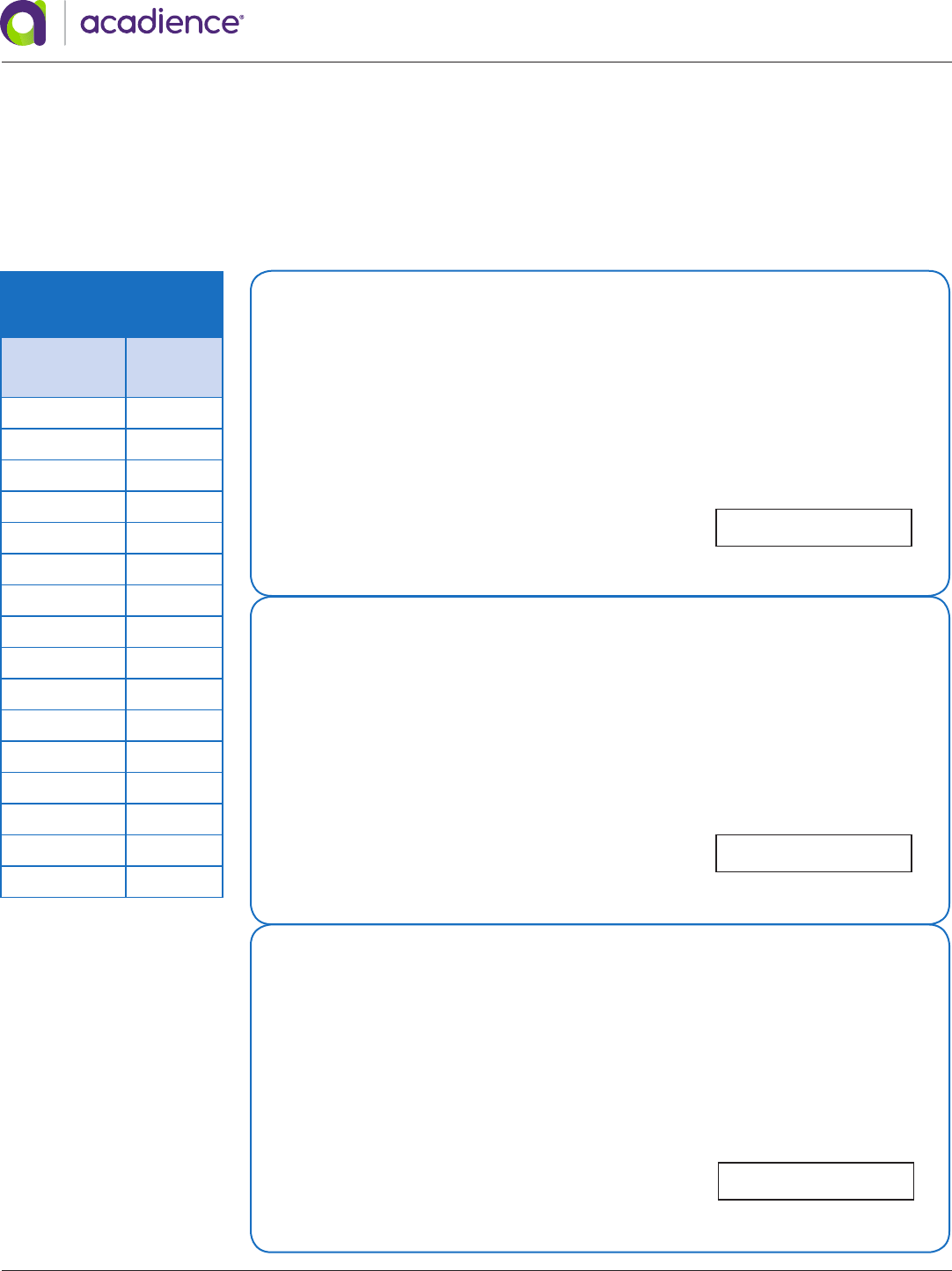
© 2021 Acadience Learning Inc. All Rights Reserved. Acadience is a registered trademark of Acadience Learning Inc.
24
The Acadience Reading Composite Score is used to interpret student results for Acadience Reading. Most data management services
will calculate the composite score for you. If you do not use a data management service or if your data management service does not
calculate it, you can use this worksheet to calculate the composite score.
Name: _____________________________________ Class: _____________________________________
Third Grade Reading Composite Score Worksheet
© Acadience Learning Inc. / March 11, 2021
reading k–6
Beginning of Year Benchmark
ORF Words Correct = ___________________ [1]
Retell Score ___________ x 2 = ___________________ [2]
Maze Adjusted Score ___________ x 4 = ___________________ [3]
ORF Accuracy Percent: _________ %
100 x (Words Correct / (Words Correct + Errors))
Accuracy Value from Table = ___________________ [4]
Acadience Reading Composite Score (add values 1–4)
=
If ORF is below 40 and Retell is not administered, use 0 for the Retell value only for calculating the Acadience
Reading Composite Score. Do not calculate the composite score if any of the values are missing.
Middle of Year Benchmark
ORF Words Correct = ___________________ [1]
Retell Score ___________ x 2 = ___________________ [2]
Maze Adjusted Score ___________ x 4 = ___________________ [3]
ORF Accuracy Percent: _________ %
100 x (Words Correct / (Words Correct + Errors))
Accuracy Value from Table = ___________________ [4]
Acadience Reading Composite Score (add values 1–4)
=
If ORF is below 40 and Retell is not administered, use 0 for the Retell value only for calculating the Acadience
Reading Composite Score. Do not calculate the composite score if any of the values are missing.
End of Year Benchmark
ORF Words Correct = ___________________ [1]
Retell Score ___________ x 2 = ___________________ [2]
Maze Adjusted Score ___________ x 4 = ___________________ [3]
ORF Accuracy Percent: _________ %
100 x (Words Correct / (Words Correct + Errors))
Accuracy Value from Table = ___________________ [4]
Acadience Reading Composite Score (add values 1–4)
=
If ORF is below 40 and Retell is not administered, use 0 for the Retell value only for calculating the Acadience
Reading Composite Score. Do not calculate the composite score if any of the values are missing.
Beginning, Middle, and
End of Year
ORF
Accuracy
Percent
Accuracy
Value
0% – 85% 0
86% 8
87% 16
88% 24
89% 32
90% 40
91% 48
92% 56
93% 64
94% 72
95% 80
96% 88
97% 96
98% 104
99% 112
100% 120
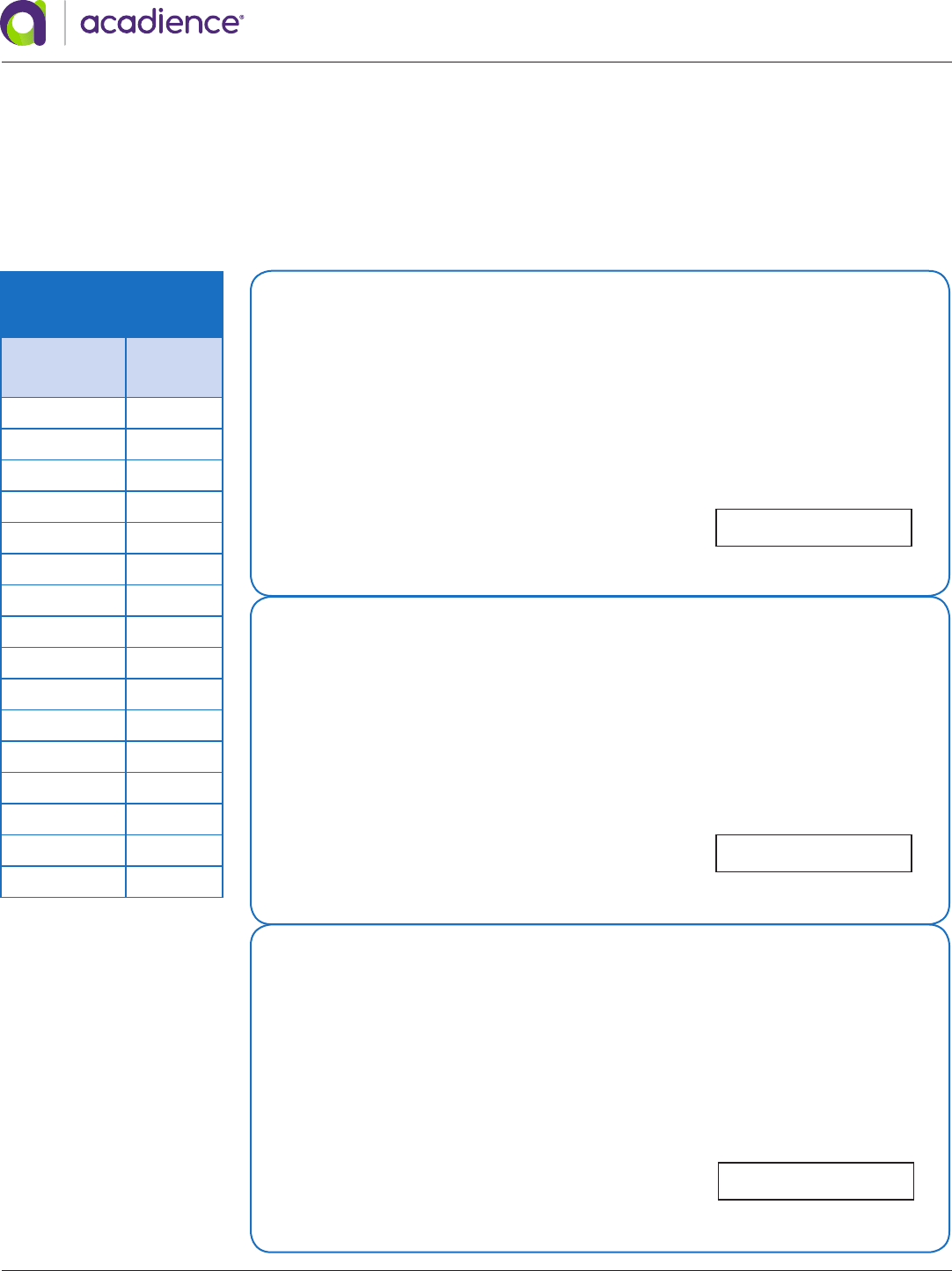
© 2021 Acadience Learning Inc. All Rights Reserved. Acadience is a registered trademark of Acadience Learning Inc.
25
The Acadience Reading Composite Score is used to interpret student results for Acadience Reading. Most data management services
will calculate the composite score for you. If you do not use a data management service or if your data management service does not
calculate it, you can use this worksheet to calculate the composite score.
Name: _____________________________________ Class: _____________________________________
Fourth Grade Reading Composite Score Worksheet
© Acadience Learning Inc. / March 11, 2021
reading k–6
Beginning of Year Benchmark
ORF Words Correct = ___________________ [1]
Retell Score ___________ x 2 = ___________________ [2]
Maze Adjusted Score ___________ x 4 = ___________________ [3]
ORF Accuracy Percent: _________ %
100 x (Words Correct / (Words Correct + Errors))
Accuracy Value from Table = ___________________ [4]
Acadience Reading Composite Score (add values 1–4)
=
If ORF is below 40 and Retell is not administered, use 0 for the Retell value only for calculating the Acadience
Reading Composite Score. Do not calculate the composite score if any of the values are missing.
Middle of Year Benchmark
ORF Words Correct = ___________________ [1]
Retell Score ___________ x 2 = ___________________ [2]
Maze Adjusted Score ___________ x 4 = ___________________ [3]
ORF Accuracy Percent: _________ %
100 x (Words Correct / (Words Correct + Errors))
Accuracy Value from Table = ___________________ [4]
Acadience Reading Composite Score (add values 1–4)
=
If ORF is below 40 and Retell is not administered, use 0 for the Retell value only for calculating the Acadience
Reading Composite Score. Do not calculate the composite score if any of the values are missing.
End of Year Benchmark
ORF Words Correct = ___________________ [1]
Retell Score ___________ x 2 = ___________________ [2]
Maze Adjusted Score ___________ x 4 = ___________________ [3]
ORF Accuracy Percent: _________ %
100 x (Words Correct / (Words Correct + Errors))
Accuracy Value from Table = ___________________ [4]
Acadience Reading Composite Score (add values 1–4)
=
If ORF is below 40 and Retell is not administered, use 0 for the Retell value only for calculating the Acadience
Reading Composite Score. Do not calculate the composite score if any of the values are missing.
Beginning, Middle, and
End of Year
ORF
Accuracy
Percent
Accuracy
Value
0% – 85% 0
86% 8
87% 16
88% 24
89% 32
90% 40
91% 48
92% 56
93% 64
94% 72
95% 80
96% 88
97% 96
98% 104
99% 112
100% 120
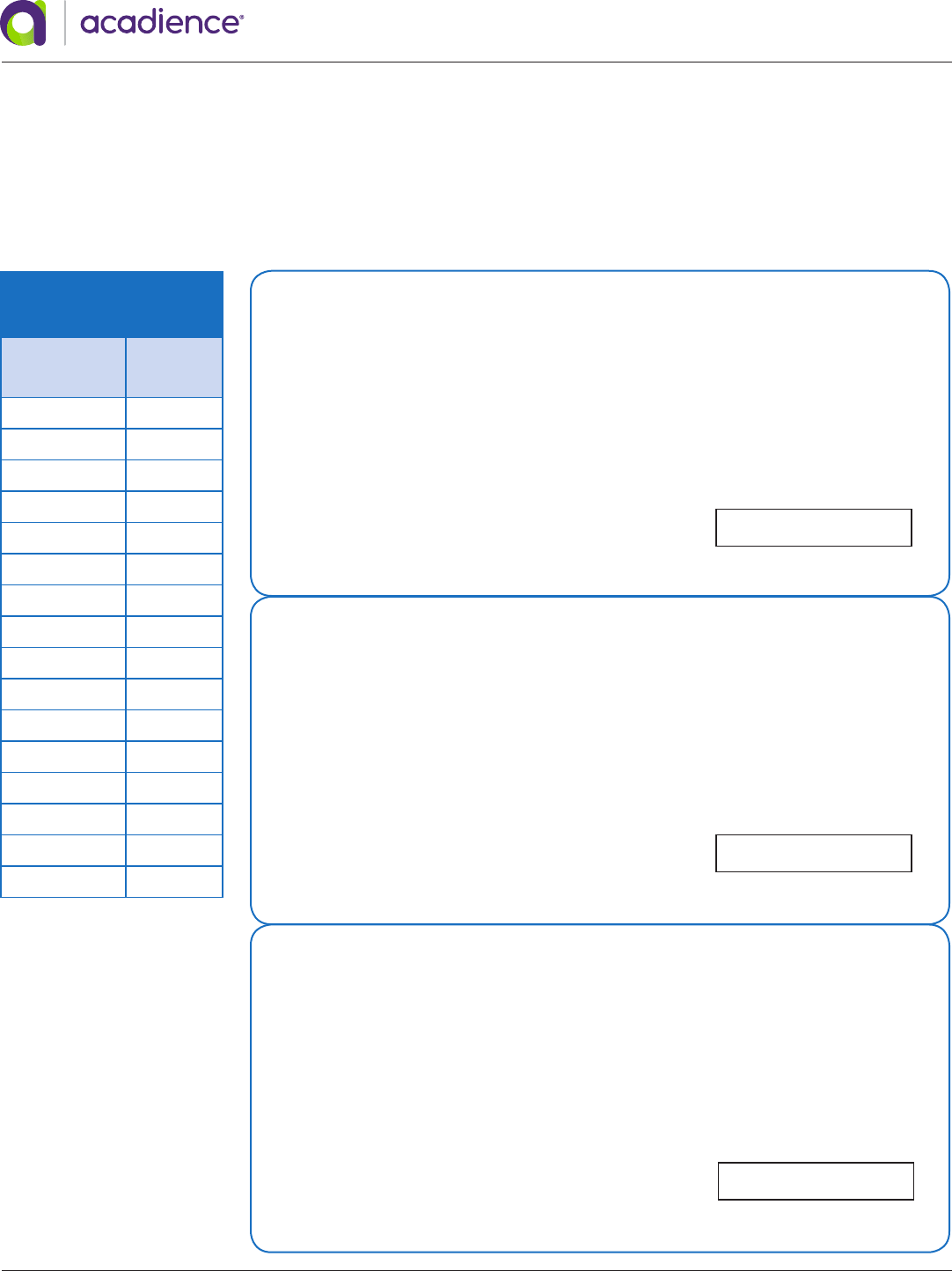
© 2021 Acadience Learning Inc. All Rights Reserved. Acadience is a registered trademark of Acadience Learning Inc.
26
The Acadience Reading Composite Score is used to interpret student results for Acadience Reading. Most data management services
will calculate the composite score for you. If you do not use a data management service or if your data management service does not
calculate it, you can use this worksheet to calculate the composite score.
Name: _____________________________________ Class: _____________________________________
Fifth Grade Reading Composite Score Worksheet
© Acadience Learning Inc. / March 11, 2021
reading k–6
Beginning of Year Benchmark
ORF Words Correct = ___________________ [1]
Retell Score ___________ x 2 = ___________________ [2]
Maze Adjusted Score ___________ x 4 = ___________________ [3]
ORF Accuracy Percent: _________ %
100 x (Words Correct / (Words Correct + Errors))
Accuracy Value from Table = ___________________ [4]
Acadience Reading Composite Score (add values 1–4)
=
If ORF is below 40 and Retell is not administered, use 0 for the Retell value only for calculating the Acadience
Reading Composite Score. Do not calculate the composite score if any of the values are missing.
Middle of Year Benchmark
ORF Words Correct = ___________________ [1]
Retell Score ___________ x 2 = ___________________ [2]
Maze Adjusted Score ___________ x 4 = ___________________ [3]
ORF Accuracy Percent: _________ %
100 x (Words Correct / (Words Correct + Errors))
Accuracy Value from Table = ___________________ [4]
Acadience Reading Composite Score (add values 1–4)
=
If ORF is below 40 and Retell is not administered, use 0 for the Retell value only for calculating the Acadience
Reading Composite Score. Do not calculate the composite score if any of the values are missing.
End of Year Benchmark
ORF Words Correct = ___________________ [1]
Retell Score ___________ x 2 = ___________________ [2]
Maze Adjusted Score ___________ x 4 = ___________________ [3]
ORF Accuracy Percent: _________ %
100 x (Words Correct / (Words Correct + Errors))
Accuracy Value from Table = ___________________ [4]
Acadience Reading Composite Score (add values 1–4)
=
If ORF is below 40 and Retell is not administered, use 0 for the Retell value only for calculating the Acadience
Reading Composite Score. Do not calculate the composite score if any of the values are missing.
Beginning, Middle, and
End of Year
ORF
Accuracy
Percent
Accuracy
Value
0% – 85% 0
86% 8
87% 16
88% 24
89% 32
90% 40
91% 48
92% 56
93% 64
94% 72
95% 80
96% 88
97% 96
98% 104
99% 112
100% 120
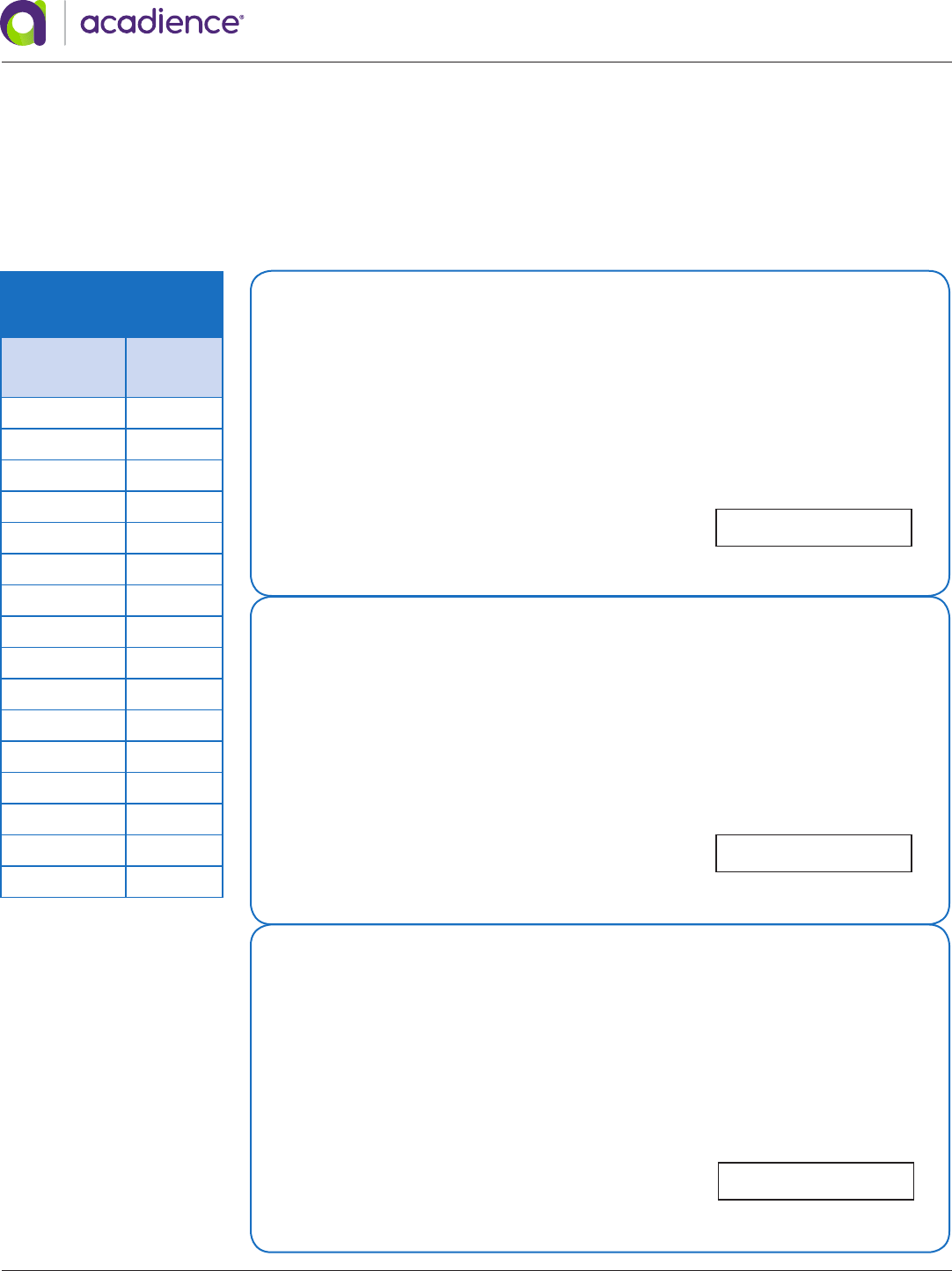
© 2021 Acadience Learning Inc. All Rights Reserved. Acadience is a registered trademark of Acadience Learning Inc.
27
The Acadience Reading Composite Score is used to interpret student results for Acadience Reading. Most data management services
will calculate the composite score for you. If you do not use a data management service or if your data management service does not
calculate it, you can use this worksheet to calculate the composite score.
Name: _____________________________________ Class: _____________________________________
Sixth Grade Reading Composite Score Worksheet
© Acadience Learning Inc. / March 11, 2021
reading k–6
Beginning of Year Benchmark
ORF Words Correct = ___________________ [1]
Retell Score ___________ x 2 = ___________________ [2]
Maze Adjusted Score ___________ x 4 = ___________________ [3]
ORF Accuracy Percent: _________ %
100 x (Words Correct / (Words Correct + Errors))
Accuracy Value from Table = ___________________ [4]
Acadience Reading Composite Score (add values 1–4)
=
If ORF is below 40 and Retell is not administered, use 0 for the Retell value only for calculating the Acadience
Reading Composite Score. Do not calculate the composite score if any of the values are missing.
Middle of Year Benchmark
ORF Words Correct = ___________________ [1]
Retell Score ___________ x 2 = ___________________ [2]
Maze Adjusted Score ___________ x 4 = ___________________ [3]
ORF Accuracy Percent: _________ %
100 x (Words Correct / (Words Correct + Errors))
Accuracy Value from Table = ___________________ [4]
Acadience Reading Composite Score (add values 1–4)
=
If ORF is below 40 and Retell is not administered, use 0 for the Retell value only for calculating the Acadience
Reading Composite Score. Do not calculate the composite score if any of the values are missing.
End of Year Benchmark
ORF Words Correct = ___________________ [1]
Retell Score ___________ x 2 = ___________________ [2]
Maze Adjusted Score ___________ x 4 = ___________________ [3]
ORF Accuracy Percent: _________ %
100 x (Words Correct / (Words Correct + Errors))
Accuracy Value from Table = ___________________ [4]
Acadience Reading Composite Score (add values 1–4)
=
If ORF is below 40 and Retell is not administered, use 0 for the Retell value only for calculating the Acadience
Reading Composite Score. Do not calculate the composite score if any of the values are missing.
Beginning, Middle, and
End of Year
ORF
Accuracy
Percent
Accuracy
Value
0% – 85% 0
86% 8
87% 16
88% 24
89% 32
90% 40
91% 48
92% 56
93% 64
94% 72
95% 80
96% 88
97% 96
98% 104
99% 112
100% 120
